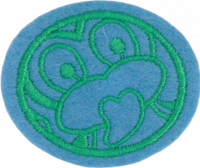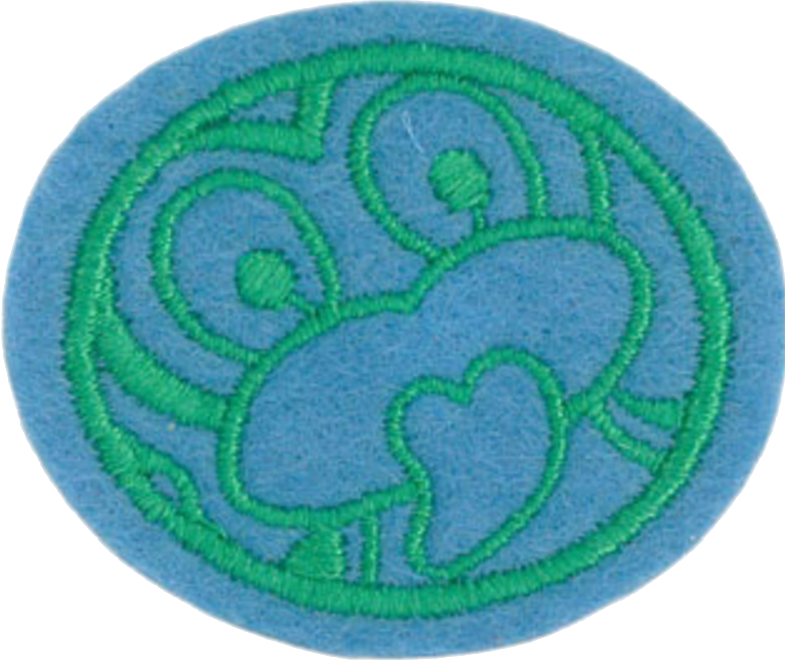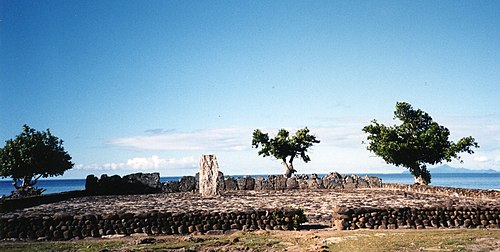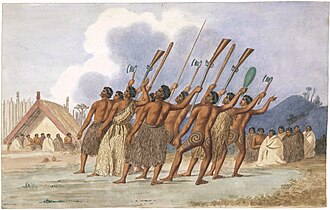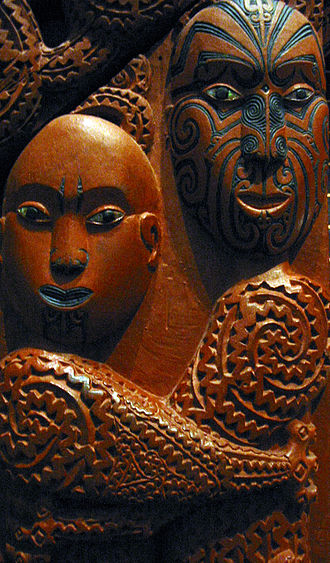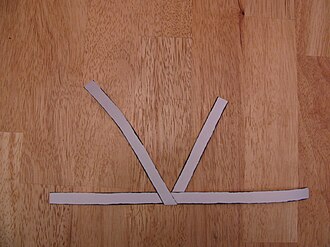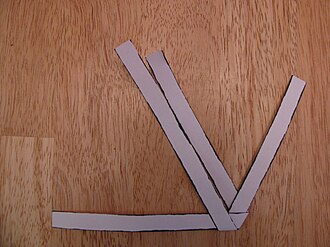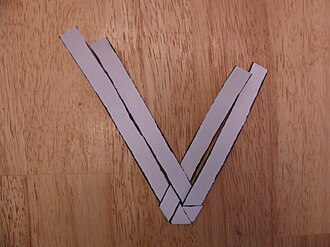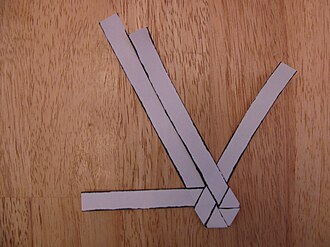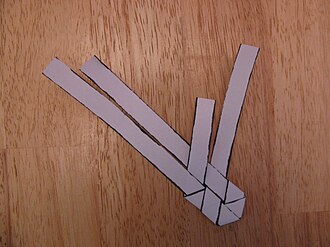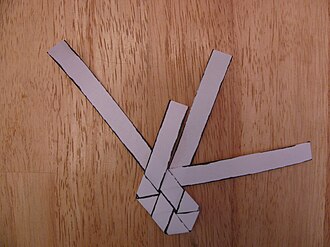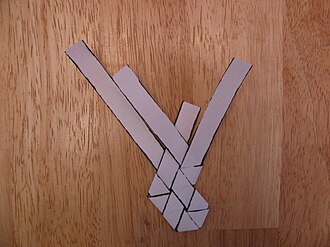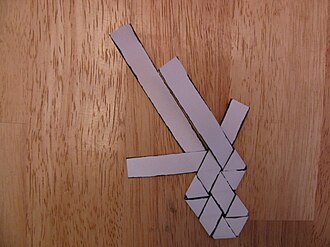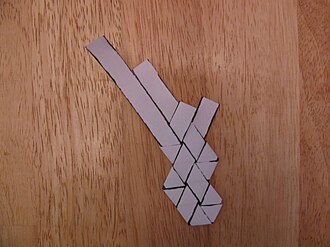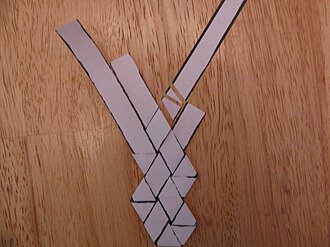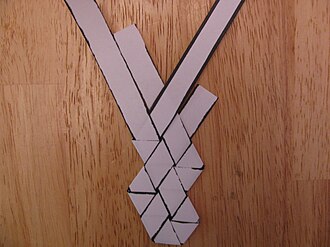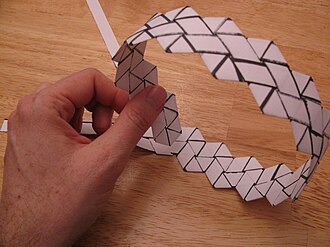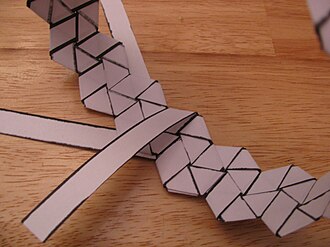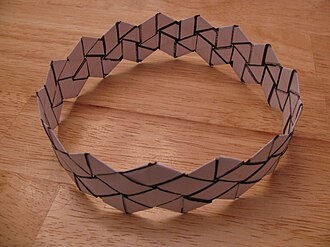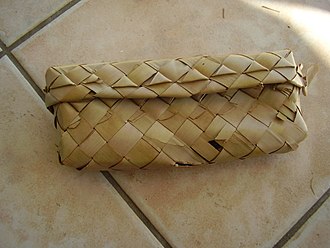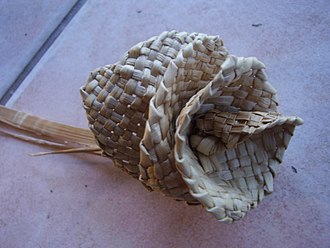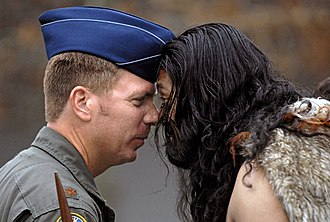Difference between revisions of "AY Honors/Māori Lore/Answer Key"
(→Weaves) |
|||
| (84 intermediate revisions by 11 users not shown) | |||
| Line 1: | Line 1: | ||
| − | [[Image: | + | {{HonorSubpage}} |
| + | <section begin="Body" /> | ||
| + | {{ansreq|page={{#titleparts:{{PAGENAME}}|2|1}}|num=1}} | ||
| + | <noinclude><translate><!--T:137--> | ||
| + | </noinclude> | ||
| + | <!-- 1. Define the following commonly used terms: --> | ||
| + | <noinclude></translate></noinclude> | ||
| + | {{ansreq|page={{#titleparts:{{PAGENAME}}|2|1}}|num=1a}} | ||
| + | <noinclude><translate><!--T:138--> | ||
| + | </noinclude> | ||
| + | [[Image:Marae, Raiatea 2.jpg|thumb|390px|Taputapuātea, an ancient marae at Ra'iātea in the Society Islands, restored in 1994.]]A '''marae''' is a sacred place which served both religious and social purposes in pre-Christian Polynesian societies and in some modern Polynesian societies, such as Māori, today. In all these languages, the word also means "cleared, free of weeds, trees, etc." It generally consists of an area of cleared land roughly rectangular (the marae itself), bordered with stones or wooden posts (called ''au'' in Tahitian and Cook Islands Māori) perhaps with terraces (''paepae'') which were used in olden times for ceremonial purposes; and with a central stone ''ahu'' or ''a'u'' (sometimes as in the Rapanui culture's ahu on Easter Island "ahu" becomes a synonym for the whole marae complex). | ||
| − | = | + | <!--T:139--> |
| − | + | <noinclude></translate></noinclude> | |
| + | {{CloseReq}} <!-- 1a --> | ||
| + | {{ansreq|page={{#titleparts:{{PAGENAME}}|2|1}}|num=1b}} <!--T:3--> | ||
| + | <noinclude><translate><!--T:140--> | ||
| + | </noinclude> | ||
| + | A Pōwhiri is a Māori welcoming ceremony involving speeches, dancing, singing and hongi. It can be performed both to welcome guests onto a marae or during other ceremonies, such as during a dedication of a building (where the performers might welcome the owners or future users of the building). A pōwhiri is not performed for every group of manuhiri (visitors). It is often reserved for special visitors or for tupapaku (the arrival of the body of the deceased) for a tangihanga (funeral). However, powhiri are also often performed for tourist groups as part of special events. | ||
| + | {{clear}} | ||
| − | == | + | <!--T:141--> |
| − | + | <noinclude></translate></noinclude> | |
| + | {{CloseReq}} <!-- 1b --> | ||
| + | {{ansreq|page={{#titleparts:{{PAGENAME}}|2|1}}|num=1c}} <!--T:4--> | ||
| + | <noinclude><translate><!--T:142--> | ||
| + | </noinclude> | ||
| + | '''Karakia''' is the Māori word for incantations and prayers. Karakia are generally used to ensure a favourable outcome of important undertakings. They are also considered a formal greeting when beginning a ceremony. According to legend, in the village of Ruatoria, there was a curse on the Waiapu River which was lifted when Hori Keeti performed Karakia. | ||
| − | == | + | <!--T:143--> |
| − | + | <noinclude></translate></noinclude> | |
| + | {{CloseReq}} <!-- 1c --> | ||
| + | {{ansreq|page={{#titleparts:{{PAGENAME}}|2|1}}|num=1d}} <!--T:5--> | ||
| + | <noinclude><translate><!--T:144--> | ||
| + | </noinclude> | ||
| + | ''Mate'' means "death" in Māori. "Ka Mate" is a Māori ''haka'' composed by Te Rauparaha, war leader of the Ngāti Toa tribe of the North Island of New Zealand: | ||
| + | the main body of the haka: | ||
| − | + | <!--T:6--> | |
| + | {| class="wikitable" | ||
| + | |-- | ||
| + | |Ka mate, ka mate! ka ora! ka ora! | ||
| + | Ka mate! ka mate! ka ora! ka ora! | ||
| − | + | <!--T:7--> | |
| − | + | Tēnei te tangata pūhuruhuru | |
| − | + | <!--T:8--> | |
| + | Nāna nei i tiki mai whakawhiti te rā | ||
| − | + | <!--T:9--> | |
| − | + | Ā, upane! ka upane! | |
| − | + | <!--T:10--> | |
| + | Ā, upane, ka upane, whiti te ra! | ||
| + | |’Tis death! ‘tis death! ''(or: I may die)'' ’Tis life! ‘tis life! ''(or: I may live)'' | ||
| + | ’Tis death! ‘tis death! ’Tis life! ‘tis life! | ||
| − | + | <!--T:11--> | |
| + | This the hairy man that stands here... | ||
| − | + | <!--T:12--> | |
| + | …who brought the sun and caused it to shine | ||
| − | + | <!--T:13--> | |
| − | + | A step upward, another step upward! | |
| − | |||
| − | + | <!--T:14--> | |
| + | A step upward, another... the Sun shines! | ||
| + | |} | ||
| − | + | <!--T:145--> | |
| + | <noinclude></translate></noinclude> | ||
| + | {{CloseReq}} <!-- 1d --> | ||
| + | {{ansreq|page={{#titleparts:{{PAGENAME}}|2|1}}|num=1e}} <!--T:15--> | ||
| + | <noinclude><translate><!--T:146--> | ||
| + | </noinclude> | ||
| + | Waiata is the Māori word for song. | ||
| + | <!--T:147--> | ||
| + | <noinclude></translate></noinclude> | ||
| + | {{CloseReq}} <!-- 1e --> | ||
| + | {{ansreq|page={{#titleparts:{{PAGENAME}}|2|1}}|num=1f}} <!--T:16--> | ||
| + | <noinclude><translate><!--T:148--> | ||
| + | </noinclude> | ||
| + | Kōrero is the spoken word. Māori is a culture based on Kōrero, the oral tradition. Māori place as much importance on the spoken word as Western cultures place on the written word. In the Western world, people are bound by written contracts and laws are written down before they may come into effect. In Māori, Kōrero is binding. | ||
| + | |||
| + | <!--T:17--> | ||
| + | [http://www.maori.org.nz/Tikanga/default.asp?pid=sp100&parent=95 www.maori.org.nz]. | ||
| + | |||
| + | <!--T:149--> | ||
| + | <noinclude></translate></noinclude> | ||
| + | {{CloseReq}} <!-- 1f --> | ||
| + | {{ansreq|page={{#titleparts:{{PAGENAME}}|2|1}}|num=1g}} <!--T:18--> | ||
| + | <noinclude><translate><!--T:150--> | ||
| + | </noinclude> | ||
| + | [[Image:MaoriWardanceKahuroa.jpg|thumb|260px|The haka is a traditional genre of Māori dance. This depiction of a haka as a war dance dates from ca. 1845.]] | ||
| + | A haka is a traditional dance form. It is a posture dance with shouted accompaniment, performed by a group. Although the use of a haka by the ''All Blacks'' (a rugby team) has made one type of haka familiar, it has led to misconceptions. Haka are not exclusively war dances, nor are they only performed by men. Some are performed by women, others by mixed groups, and some simple haka are performed by children. Haka are performed for various reasons: for amusement, as a hearty welcome to distinguished guests, or to acknowledge great achievements or occasions. War haka, which had their own term, 'peruperu', were originally performed by warriors before a battle, proclaiming their strength and prowess in order to intimidate the opposition. Today, haka constitute an integral part of formal or official welcome ceremonies for distinguished visitors or foreign dignitaries, serving to impart a sense of the importance of the occasion. | ||
| + | |||
| + | <!--T:151--> | ||
| + | <noinclude></translate></noinclude> | ||
| + | {{CloseReq}} <!-- 1g --> | ||
| + | {{ansreq|page={{#titleparts:{{PAGENAME}}|2|1}}|num=1h}} <!--T:19--> | ||
| + | <noinclude><translate><!--T:152--> | ||
| + | </noinclude> | ||
| + | ''Kuia'' (also ''kui'') is the Māori word for "grandmother". | ||
| + | |||
| + | <!--T:153--> | ||
| + | <noinclude></translate></noinclude> | ||
| + | {{CloseReq}} <!-- 1h --> | ||
| + | {{ansreq|page={{#titleparts:{{PAGENAME}}|2|1}}|num=1i}} <!--T:20--> | ||
| + | <noinclude><translate><!--T:154--> | ||
| + | </noinclude> | ||
| + | In the Māori language, ''Tāne'' means "man". | ||
| + | |||
| + | <!--T:155--> | ||
| + | <noinclude></translate></noinclude> | ||
| + | {{CloseReq}} <!-- 1i --> | ||
| + | {{ansreq|page={{#titleparts:{{PAGENAME}}|2|1}}|num=1j}} <!--T:21--> | ||
| + | <noinclude><translate><!--T:156--> | ||
| + | </noinclude> | ||
| + | In the Māori language, ''Wero'' means "challenge". At the beginning of a Powhiri, the people must first determine if the visitors have peaceful intentions or not. This is done through the wero which literally means "to cast a spear." The warriors performing the wero will make frightening gestures with spears. Once the challenge is complete, the warriors will guide the visitors to the marae where they will be welcomed by the women and children. | ||
| + | |||
| + | <!--T:157--> | ||
| + | <noinclude></translate></noinclude> | ||
| + | {{CloseReq}} <!-- 1j --> | ||
| + | {{ansreq|page={{#titleparts:{{PAGENAME}}|2|1}}|num=1k}} <!--T:22--> | ||
| + | <noinclude><translate><!--T:158--> | ||
| + | </noinclude> | ||
| + | In Polynesian culture (for example, Hawaiian and Māori), mana is a spiritual quality considered to have supernatural origin – a sacred impersonal force existing in the universe. Therefore to have ''mana'' is to have influence and authority, and efficacy – the power to perform in a given situation. This essential quality of ''mana'' is not limited to persons – peoples, governments, places and inanimate objects can possess ''mana''. In Hawaiian, ''mana loa'' means "great power". People or objects that possess ''mana'' are accorded "respect"; because their possession of ''mana'' gives them "authority", "power", and "prestige". In Māori, a tribe that has ''mana whenua'' is considered to have demonstrated their authority over a given piece of land or territory. The word’s meaning is complex because ''mana'' is a basic foundation of the Polynesian worldview. | ||
| + | |||
| + | <!--T:23--> | ||
| + | The magazine ''Māori Law Review'' suggests two essential aspects to a Māori person's ''mana'': | ||
| + | |||
| + | <!--T:24--> | ||
| + | * ''mana tangata'', authority derived from ''whakapapa'' connections, and | ||
| + | * ''mana huaanga'', defined as "authority derived from having a wealth of resources to gift to others to bind them into reciprocal obligations". | ||
| + | |||
| + | <!--T:159--> | ||
| + | <noinclude></translate></noinclude> | ||
| + | {{CloseReq}} <!-- 1k --> | ||
| + | {{ansreq|page={{#titleparts:{{PAGENAME}}|2|1}}|num=1l}} <!--T:25--> | ||
| + | <noinclude><translate><!--T:160--> | ||
| + | </noinclude> | ||
| + | Manuhiri are visitors. Locals and visitors have to respect certain rules, especially during the rituals of encounter. This is when the phrase tāngata whenua (people of the land) comes into play. Should a group of people come to stay on a marae, they are considered manuhiri (guests) while the owners of the marae are known as tāngata whenua. Should other groups of manuhiri arrive, the manuhiri who arrived previously - regardless of their race - are considered tāngata whenua for the purposes of formally welcoming the new group. When Māori refer to themselves as tāngata whenua this is not done solely to emphasise their indigenous status, as is often assumed, because the connotation in Māori of the phrase is one not of separation but rather of welcome and inclusion. | ||
| + | |||
| + | <!--T:161--> | ||
| + | <noinclude></translate></noinclude> | ||
| + | {{CloseReq}} <!-- 1l --> | ||
| + | {{ansreq|page={{#titleparts:{{PAGENAME}}|2|1}}|num=1m}} <!--T:26--> | ||
| + | <noinclude><translate><!--T:162--> | ||
| + | </noinclude> | ||
| + | A '''Hongi''' is a traditional Māori greeting in New Zealand. It is done by pressing one's nose to another person at an encounter. See below. | ||
| + | |||
| + | <!--T:163--> | ||
| + | <noinclude></translate></noinclude> | ||
| + | {{CloseReq}} <!-- 1m --> | ||
| + | {{ansreq|page={{#titleparts:{{PAGENAME}}|2|1}}|num=1n}} <!--T:27--> | ||
| + | <noinclude><translate><!--T:164--> | ||
| + | </noinclude> | ||
| + | A hui is a New Zealand Māori social gathering or assembly in a Māori community. | ||
| + | |||
| + | <!--T:165--> | ||
| + | <noinclude></translate></noinclude> | ||
| + | {{CloseReq}} <!-- 1n --> | ||
| + | {{ansreq|page={{#titleparts:{{PAGENAME}}|2|1}}|num=1o}} <!--T:28--> | ||
| + | <noinclude><translate><!--T:166--> | ||
| + | </noinclude> | ||
| + | Poroporoaki is the final farewell during a ''powhiri''. When the poroporoaki is concluded, the ''mana'' returns to the host. It is a solemn occasion during which the people reflect on the welcome they have received, and recognize that they may not experience another ''powhiri'' before their death. | ||
| + | |||
| + | <!--T:167--> | ||
| + | <noinclude></translate></noinclude> | ||
| + | {{CloseReq}} <!-- 1o --> | ||
| + | {{ansreq|page={{#titleparts:{{PAGENAME}}|2|1}}|num=1p}} <!--T:29--> | ||
| + | <noinclude><translate><!--T:168--> | ||
| + | </noinclude> | ||
| + | Whānau is a Māori-language word for extended family. Other meanings, though less commonly used in English, are to give birth, or genus. | ||
| + | |||
| + | <!--T:169--> | ||
| + | <noinclude></translate></noinclude> | ||
| + | {{CloseReq}} <!-- 1p --> | ||
| + | {{ansreq|page={{#titleparts:{{PAGENAME}}|2|1}}|num=1q}} <!--T:30--> | ||
| + | <noinclude><translate><!--T:170--> | ||
| + | </noinclude> | ||
| + | Tangi is a Māori funeral rite. | ||
| + | |||
| + | <!--T:171--> | ||
| + | <noinclude></translate></noinclude> | ||
| + | {{CloseReq}} <!-- 1q --> | ||
| + | {{ansreq|page={{#titleparts:{{PAGENAME}}|2|1}}|num=1r}} <!--T:31--> | ||
| + | <noinclude><translate><!--T:172--> | ||
| + | </noinclude> | ||
| + | ''Aroha'' can be best translated as "love," but the meaning is deeper than that. The Māori believe that ''Aroha'' is the force that binds the universe together. | ||
| + | |||
| + | <!--T:173--> | ||
| + | <noinclude></translate></noinclude> | ||
| + | {{CloseReq}} <!-- 1r --> | ||
| + | {{ansreq|page={{#titleparts:{{PAGENAME}}|2|1}}|num=1s}} <!--T:32--> | ||
| + | <noinclude><translate><!--T:174--> | ||
| + | </noinclude> | ||
| + | Whakairo is a Māori form of carving. Carvings are made from wood, jade, bone, or basalt. | ||
| + | |||
| + | <!--T:175--> | ||
| + | <noinclude></translate></noinclude> | ||
| + | {{CloseReq}} <!-- 1s --> | ||
| + | {{ansreq|page={{#titleparts:{{PAGENAME}}|2|1}}|num=1t}} <!--T:33--> | ||
| + | <noinclude><translate><!--T:176--> | ||
| + | </noinclude> | ||
| + | ''Koro'' is a Māori chief. | ||
| + | |||
| + | <!--T:177--> | ||
| + | <noinclude></translate></noinclude> | ||
| + | {{CloseReq}} <!-- 1t --> | ||
| + | {{ansreq|page={{#titleparts:{{PAGENAME}}|2|1}}|num=1u}} <!--T:34--> | ||
| + | <noinclude><translate><!--T:178--> | ||
| + | </noinclude> | ||
| + | Kaumatua are respected tribal elders of either gender in a Māori community who have been involved with their whānau for a number of years. They are appointed by their people who believe the chosen elders have the capacity to teach and guide both current and future generations. | ||
| + | |||
| + | <!--T:179--> | ||
| + | <noinclude></translate></noinclude> | ||
| + | {{CloseReq}} <!-- 1u --> | ||
| + | {{ansreq|page={{#titleparts:{{PAGENAME}}|2|1}}|num=1v}} <!--T:35--> | ||
| + | <noinclude><translate><!--T:180--> | ||
| + | </noinclude> | ||
| + | ''Wahine'' is the Māori word for "woman". | ||
| + | |||
| + | <!--T:181--> | ||
| + | <noinclude></translate></noinclude> | ||
| + | {{CloseReq}} <!-- 1v --> | ||
| + | {{ansreq|page={{#titleparts:{{PAGENAME}}|2|1}}|num=1w}} <!--T:36--> | ||
| + | <noinclude><translate><!--T:182--> | ||
| + | </noinclude> | ||
| + | A Māori word literally meaning "homage" or "respect". | ||
| + | |||
| + | <!--T:183--> | ||
| + | <noinclude></translate></noinclude> | ||
| + | {{CloseReq}} <!-- 1w --> | ||
| + | {{ansreq|page={{#titleparts:{{PAGENAME}}|2|1}}|num=1x}} <!--T:37--> | ||
| + | <noinclude><translate><!--T:184--> | ||
| + | </noinclude> | ||
| + | Whaikorero means "formal speech" or "oration". | ||
| + | |||
| + | <!--T:185--> | ||
| + | <noinclude></translate></noinclude> | ||
| + | {{CloseReq}} <!-- 1x --> | ||
| + | {{ansreq|page={{#titleparts:{{PAGENAME}}|2|1}}|num=1y}} <!--T:38--> | ||
| + | <noinclude><translate><!--T:186--> | ||
| + | </noinclude> | ||
| + | Tangata whenua is a Māori term literally meaning "people of the land", from tangata, 'people' and whenua land. In the context of tribal descent and ownership of land, tangata whenua are the people who descend from the first people to settle the land of the district, whereas the actual mana may reside with later arrivals. However, in the context of a marae, the tangata whenua are the owners of the marae, in contradistinction to the manuhiri or guests. After the welcoming ceremony on a marae, the guests may be afforded the temporary, honorary status of tangata whenua, and may even be invited to participate as locals as the ceremonies continue. In the national context of New Zealand, Māori are the tangata whenua, and in this sense the term is equivalent to 'indigenous'. | ||
| + | |||
| + | <!--T:187--> | ||
| + | <noinclude></translate></noinclude> | ||
| + | {{CloseReq}} <!-- 1y --> | ||
| + | {{ansreq|page={{#titleparts:{{PAGENAME}}|2|1}}|num=1z}} <!--T:39--> | ||
| + | <noinclude><translate><!--T:188--> | ||
| + | </noinclude> | ||
| + | A taonga in Māori culture is a treasured thing, whether tangible or intangible. Tangible examples are all sorts of heirlooms and artefacts, land and fisheries. Intangible examples may include language, spiritual beliefs, radio frequencies and riparian rights. | ||
| + | |||
| + | <!--T:189--> | ||
| + | <noinclude></translate></noinclude> | ||
| + | {{CloseReq}} <!-- 1z --> | ||
| + | {{CloseReq}} <!-- 1 --> | ||
| + | {{ansreq|page={{#titleparts:{{PAGENAME}}|2|1}}|num=2}} | ||
| + | <noinclude><translate><!--T:190--> | ||
| + | </noinclude> | ||
| + | <!-- 2. Complete the following: --> | ||
| + | |||
| + | <!--T:191--> | ||
| + | <noinclude></translate></noinclude> | ||
| + | {{ansreq|page={{#titleparts:{{PAGENAME}}|2|1}}|num=2a}} <!--T:40--> | ||
| + | <noinclude><translate><!--T:192--> | ||
| + | </noinclude> | ||
| + | [[File:Polynesian Migration.svg|thumb|600px|center|<center>Polynesian migration routes</center>]] | ||
| + | |||
| + | <!--T:193--> | ||
| + | <noinclude></translate></noinclude> | ||
| + | {{CloseReq}} <!-- 2a --> | ||
| + | {{ansreq|page={{#titleparts:{{PAGENAME}}|2|1}}|num=2b}} <!--T:41--> | ||
| + | <noinclude><translate><!--T:194--> | ||
| + | </noinclude> | ||
| + | Various Māori traditions recount how their ancestors set out from a mythical homeland in great ocean-going canoes (or waka). Some of these traditions name the homeland as Hawaiki. | ||
| + | |||
| + | <!--T:195--> | ||
| + | <noinclude></translate></noinclude> | ||
| + | {{CloseReq}} <!-- 2b --> | ||
| + | {{ansreq|page={{#titleparts:{{PAGENAME}}|2|1}}|num=2c}} <!--T:42--> | ||
| + | <noinclude><translate><!--T:196--> | ||
| + | </noinclude> | ||
| + | Various Māori traditions recount how their ancestors set out from a mythical homeland in great ocean-going canoes (or waka). Some of these traditions name the homeland as Hawaiki. | ||
| + | |||
| + | <!--T:43--> | ||
| + | Among these is the story of Kupe, who had eloped with Kuramarotini, the wife of Hoturapa, the owner of the great canoe Matahourua, whom Kupe had murdered. To escape punishment for the murder, Kupe and Kura fled in Matahourua and discovered a land he called Aotearoa ('long-white-cloud'). He explored its coast and killed the sea monster Te Wheke-a-Muturangi, finally returning to his home to spread news of his newly discovered land. | ||
| + | |||
| + | <!--T:44--> | ||
| + | Other stories of various other tribes report migrations to escape famine, over-population, and warfare. These were made in legendary canoes, the best known of which are Aotea, Arawa, Kurahaupō, Mataatua, Tainui, Tākitimu, and Tokomaru. Various traditions name numerous other canoes. Some, including the Āraiteuru, are well known; others including the Kirauta and the sacred Arahura and Mahangaatuamatua are little known. Rather than arriving in a single fleet, the journeys may have occurred over several centuries. | ||
| + | |||
| + | <!--T:45--> | ||
| + | An important early collector and preserver of Māori traditions was the surveyor and ethnologist Stephenson Percy Smith. He believed that while the Polynesian traditions may have been flawed in detail, they preserved the threads of truth which could be recovered using a method already well established for Hawaiian traditions by Fornander (1878-1885). This method involved seeking out common elements of tradition from different sources, and aligning these to genealogies to give a time frame for the events. Abraham Fornander, Smith, and others used this method to reconstruct the migrations of the Polynesians, tracing them back to a supposed ancient homeland in India. | ||
| + | |||
| + | <!--T:46--> | ||
| + | S. Percy Smith used the Fornander method, combining disparate traditions from various parts of New Zealand and other parts of Polynesia, to derive a now discredited version of Māori migration to New Zealand -- the 'Great Fleet' hypothesis. Through an examination of the genealogies of various tribes, he came up with a set of precise dates for his 'Great Fleet' and the explorers that he and others posited as having paved the way for the fleet. | ||
| + | |||
| + | <!--T:47--> | ||
| + | According to Te Ara Encyclopedia of New Zealand, "Smith’s account went as follows. In 750 AD the Polynesian explorer Kupe discovered an uninhabited New Zealand. Then in 1000–1100 AD, the Polynesian explorers Toi and Whātonga visited New Zealand, and found it inhabited by a primitive, nomadic people known as the Moriori. Finally, in 1350 AD a ‘great fleet’ of seven canoes – Aotea, Kurahaupō, Mataatua, Tainui, Tokomaru, Te Arawa and Tākitimu – all departed from the Tahitian region at the same time, bringing the people now known as Māori to New Zealand. These were advanced, warlike, agricultural tribes who destroyed the Moriori." The great fleet scenario won general acceptance, its adherents even including the famous Māori ethnologist Te Rangi Hīroa (Sir Peter Buck), and was taught in New Zealand schools. However it was effectively demolished during the 1960s by the ethnologist David Simmons, who showed that it derived from an incomplete and indiscriminate study of Māori tradition as recorded in the 19th Century. Simmons also suggests that some of these 'migrations' may actually have been journeys within New Zealand. | ||
| + | |||
| + | <!--T:48--> | ||
| + | Historian Rāwiri Taonui, writing in 2006 for the website Te Ara - the Encyclopedia of New Zealand, accuses Smith of falsification: "The Great Fleet theory was the result of a collaboration between the 19th-century ethnologist S. Percy Smith and the Māori scholar Hoani Te Whatahoro Jury. Smith obtained details about places in Rarotonga and Tahiti during a visit in 1897, while Jury provided information about Māori canoes in New Zealand. Smith then ‘cut and pasted’ his material, combining several oral traditions into new ones. Their joint work was published in two books, in which Jury and Smith falsely attributed much of their information to two 19th-century tohunga, Moihi Te Mātorohanga and Nēpia Pōhūhū" (Taonui 2006). | ||
| + | |||
| + | <!--T:197--> | ||
| + | <noinclude></translate></noinclude> | ||
| + | {{CloseReq}} <!-- 2c --> | ||
| + | {{ansreq|page={{#titleparts:{{PAGENAME}}|2|1}}|num=2d}} <!--T:49--> | ||
| + | <noinclude><translate><!--T:198--> | ||
| + | </noinclude> | ||
| + | |||
| + | <!--T:50--> | ||
| + | {{AY Honors/Problematic requirement | ||
| + | |"Make in the canoe" is obviously a grammatical gaffe.It was most probably supposed to say to "mark". | ||
| + | |Draw or trace a map of New Zealand showing all the major tribal areas, and the name of the canoe for each. | ||
| + | }} | ||
| + | |||
| + | <!--T:51--> | ||
| + | [[Image:IwiMap.png|Tribal areas of New Zealand]] | ||
| + | |||
| + | <!--T:52--> | ||
| + | These are the seven legendary canoes proposed by historian Stephenson Percy Smith in his "Great Fleet hypothesis." Various traditions name numerous other canoes. | ||
| + | |||
| + | <!--T:53--> | ||
| + | {| class="wikitable" | ||
| + | ! '''Name of Canoe''' | ||
| + | ! '''Regional Traditions''' | ||
| + | ! '''Associated Iwi or Hapu''' | ||
| + | |- | ||
| + | | Aotea || Taranaki, Waikato || Ngā Rauru Kītahi, Ngāti Ruanui | ||
| + | |- | ||
| + | | Te Arawa || Bay of Plenty, East Coast, Waikato || Ngāti Tūwharetoa, Te Arawa | ||
| + | |- | ||
| + | | Kurahaupō || Northland, Taranaki || Ngati Apa, Ngāti Kurī, Ngati Ruanui | ||
| + | |- | ||
| + | | Mataatua || Bay of Plenty, Northland || Ngā Puhi, Ngāi Te Rangi, Ngāti Awa, Ngāti Pūkenga, Te Whakatōhea | ||
| + | |- | ||
| + | | Tainui || Auckland, Bay of Plenty, Taranaki, Waikato || Ngāti Raukawa Ngāti Maniapoto, Ngāti Maru, Ngāti Pāoa, Ngāti Rongoū, Ngāti Tamaterā, Ngāti Whanaunga | ||
| + | |- | ||
| + | | Tākitimu || Bay of Plenty, East Coast, South Island || Muriwhenua, Ngāti Kahungunu, Ngāti Ranginui, Ngāi Tahu | ||
| + | |- | ||
| + | | Tokomaru || Taranaki || Ngati Tama, Ngati Mutunga, Ngati Rāhiri, Manukorihi, Puketapu, Te Atiawa, Ngati Maru | ||
| + | |- | ||
| + | |} | ||
| + | |||
| + | <!--T:199--> | ||
| + | <noinclude></translate></noinclude> | ||
| + | {{CloseReq}} <!-- 2d --> | ||
| + | {{ansreq|page={{#titleparts:{{PAGENAME}}|2|1}}|num=2e}} <!--T:54--> | ||
| + | <noinclude><translate><!--T:200--> | ||
| + | </noinclude> | ||
| + | [[Image:Rangitoto island from north head.jpg|thumb|600px|left|Rangitoto Island as viewed from North Head.]] | ||
| + | Rangitoto Island is a volcanic island in the Hauraki Gulf near Auckland, New Zealand. Rangitoto is Māori for 'Bloody Sky', with the name coming from the full phrase Nga Rangi-i-totongia-a Tama-te-kapua ('The days of the bleeding of Tama-te-kapua'). | ||
| + | {{clear}} | ||
| + | |||
| + | <!--T:201--> | ||
| + | <noinclude></translate></noinclude> | ||
| + | {{CloseReq}} <!-- 2e --> | ||
| + | {{CloseReq}} <!-- 2 --> | ||
| + | {{ansreq|page={{#titleparts:{{PAGENAME}}|2|1}}|num=3}} | ||
| + | <noinclude><translate><!--T:202--> | ||
| + | </noinclude> | ||
| + | <!-- 3. Visit a marae with a group that has been called to a hui. Write a report on the events that take place from the time you arrive at the marae to the time you leave. State the name of the marae, its locality and the tribe to which it is affiliated. --> | ||
| + | |||
| + | <!--T:133--> | ||
| + | {{AY Honors/Problematic requirement | ||
| + | |This honor originated in the SPD, targeted a New Zealand Pathfinders who could visit a marae event with reasonable ease. When accepted by the GC is was not modified to reflect the goal of making all honors accessible to all Pathfinders. | ||
| + | |Suggested alternative requirement: Research a marae and write a report detailing their history and structure. | ||
| + | }} | ||
| + | A hui can be called for many reasons, including a wedding, birth, funeral, or even a meeting to discuss community decisions. | ||
| + | |||
| + | <!--T:56--> | ||
| + | If you arrive at the marae before the rest of your group, wait for them before entering. Visitors are always welcomed in groups, and to enter all by yourself is a violation of protocol. When your whole group has arrived, you may enter the marae, and you will be welcomed in a powhiri ceremony. | ||
| + | |||
| + | <!--T:57--> | ||
| + | It might be a good idea to bring a small notebook and pen along so you can take notes about what is happening. A hui follows a prescribed structure. If you do not understand everything that happens, ask your host afterwards. | ||
| + | |||
| + | <!--T:203--> | ||
| + | <noinclude></translate></noinclude> | ||
| + | {{CloseReq}} <!-- 3 --> | ||
| + | {{ansreq|page={{#titleparts:{{PAGENAME}}|2|1}}|num=4}} | ||
| + | <noinclude><translate><!--T:204--> | ||
| + | </noinclude> | ||
| + | <!-- 4. Briefly relate the customs observed at each of the following events: --> | ||
| + | <noinclude></translate></noinclude> | ||
| + | {{ansreq|page={{#titleparts:{{PAGENAME}}|2|1}}|num=4a}} | ||
| + | <noinclude><translate><!--T:205--> | ||
| + | </noinclude> | ||
| + | As described previously, ''mate'' means "death" in Māori. | ||
| + | |||
| + | <!--T:59--> | ||
| + | Tangihanga, or more commonly, Tangi, is a Māori funeral rite. Tangihanga takes place at a marae, and each manuhiri (visiting group) receives a pohiri (formal greeting). Some tribes will not perform a pohiri after dark, so the visitors must arrive before dusk. | ||
| + | |||
| + | <!--T:60--> | ||
| + | A collection is taken up to defray the costs of embalming, to defray the costs of the marae, or both. | ||
| + | |||
| + | <!--T:61--> | ||
| + | On the final night of the tangihanga, people tell stories, sing, and tell jokes to help cheer the grieving family. Burial takes place the following day. After the body is lowered into the grave, people are given an opportunity to say a final farewell. Then everyone present files by the grave and throws in either a flower or a handful of soil. | ||
| + | |||
| + | <!--T:62--> | ||
| + | If the deceased lived near the cemetery, the people go there after the burial and bless the house. Otherwise, this is done sometime later. After the house blessing, a Hakari (final feast) is held, during which people will speak or perform. The Hakari is a celebration and affirmation of life. | ||
| + | |||
| + | <!--T:206--> | ||
| + | <noinclude></translate></noinclude> | ||
| + | {{CloseReq}} <!-- 4a --> | ||
| + | {{ansreq|page={{#titleparts:{{PAGENAME}}|2|1}}|num=4b}} <!--T:63--> | ||
| + | <noinclude><translate><!--T:207--> | ||
| + | </noinclude> | ||
| + | Food was considered communal property among the Māori. It was distributed by an official who was placed in charge of the food warehouse. Communal ownership of food prevented an unlucky fisherman (and his family) from going hungry. | ||
| + | |||
| + | <!--T:64--> | ||
| + | Before contact with Europeans was established, the Māori diet consisted primarily of vegetables, though fish was not an uncommon food. They correctly believed that diet affected health, and that regular bowels were an important aspect of general health. | ||
| + | |||
| + | <!--T:65--> | ||
| + | The Māori ate two meals per day. Breakfast was eaten a few hours after waking, and dinner was eaten in the early evening. A light snack sufficed for lunch. | ||
| + | |||
| + | <!--T:208--> | ||
| + | <noinclude></translate></noinclude> | ||
| + | {{CloseReq}} <!-- 4b --> | ||
| + | {{ansreq|page={{#titleparts:{{PAGENAME}}|2|1}}|num=4c}} <!--T:66--> | ||
| + | <noinclude><translate><!--T:209--> | ||
| + | </noinclude> | ||
| + | The history of individual tribal groups is kept by means of narratives, songs and chants, hence the importance of music, story and poetry. Oratory, the making of speeches, is especially important in the rituals of encounter, and it is regarded as important for a speaker to include allusions to traditional narrative and to a complex system of proverbial sayings, called whakataukī. | ||
| + | |||
| + | <!--T:67--> | ||
| + | Formal speeches are delivered at marae, and as the orator speaks, he re-enacts portions of the Māori creation story when Tāne separated the earth (his mother) from the sky (his father), thus allowing himself and his siblings to see light. During the oration, this re-enactment represents light (or understanding) coming to the people. | ||
| + | |||
| + | <!--T:210--> | ||
| + | <noinclude></translate></noinclude> | ||
| + | {{CloseReq}} <!-- 4c --> | ||
| + | {{ansreq|page={{#titleparts:{{PAGENAME}}|2|1}}|num=4d}} <!--T:68--> | ||
| + | <noinclude><translate><!--T:211--> | ||
| + | </noinclude> | ||
| + | In some cases, guests to a marae may spend the night. When this happens, the hosts provide mattresses on the floor, but no beds. Everyone sleeps in a common room, and the guests are not separated by gender. | ||
| + | |||
| + | <!--T:69--> | ||
| + | It is considered ''very'' bad manners to step over the body of a sleeping person. Stepping over a person's head is absolutely forbidden, as a person's head is considered the most ''tapu'' (sacred) part of a person. | ||
| + | |||
| + | <!--T:70--> | ||
| + | The Māori also observe customs to determine where guests and hosts sleep. The guests sleep in the tapu part of the house, which is located along the right wall as one enters the building. Hosts sleep on the ''noa'' (common) side which is on the left. Further, the chief among the visitors will sleep in the corner near a window, and visitors are ordered in a way which is related to the order in which they speak. | ||
| + | |||
| + | <!--T:212--> | ||
| + | <noinclude></translate></noinclude> | ||
| + | {{CloseReq}} <!-- 4d --> | ||
| + | {{CloseReq}} <!-- 4 --> | ||
| + | {{ansreq|page={{#titleparts:{{PAGENAME}}|2|1}}|num=5}} | ||
| + | <noinclude><translate><!--T:213--> | ||
| + | </noinclude> | ||
| + | <!-- 5. Complete the following: --> | ||
| + | <noinclude></translate></noinclude> | ||
| + | {{ansreq|page={{#titleparts:{{PAGENAME}}|2|1}}|num=5a}} <!--T:71--> | ||
| + | <noinclude><translate><!--T:214--> | ||
| + | </noinclude> | ||
| + | Of the Māori who claim a religion, 98% today identify themselves as Christian. The largest denominations in the 2006 census were Anglicans (about 14% of the population), Catholics (about 12%), Presbyterians (about 9%), and Methodists (about 3%). Around 5% of the population identified themselves as Christian without associating themselves with any particular denomination. | ||
| + | |||
| + | <!--T:72--> | ||
| + | For the purposes of this requirement though, we will not consider these as "Māori" religions, as they were introduced by the Europeans. "The" two Māori religions in use today could arguably be the original Māori religion practiced before the Europeans arrived, and Ratana. | ||
| + | |||
| + | ====Māori Religion==== <!--T:73--> | ||
| + | Traditional Māori religion, that is, the pre-European belief system of the Māori, was little modified from that of their tropical Eastern Polynesian homeland (Hawaiki Nui), conceiving of everything, including natural elements and all living things as connected by common descent through whakapapa or genealogy. Accordingly, all things were thought of as possessing a life force or mauri. As an illustration of this concept of connectedness through genealogy, consider a few of the major personifications of pre-contact times: Tangaroa was the personification of the ocean and the ancestor or origin of all fish; Tāne was the personification of the forest and the origin of all birds; and Rongo was the personification of peaceful activities and agriculture and the ancestor of cultivation. | ||
| + | |||
| + | <!--T:74--> | ||
| + | Certain practices are followed that relate to traditional concepts like tapu. Certain people and objects contain mana - spiritual power or essence. In earlier times, tribal members of a higher rank would not touch objects which belonged to members of a lower rank. This was considered "pollution" and persons of a lower rank could not touch the belongings of a highborn person without putting themselves at risk of death. | ||
| + | |||
| + | <!--T:75--> | ||
| + | Tapu can be interpreted as "sacred", as "spiritual restriction" or "implied prohibition"; it involves rules and prohibitions. There are two kinds of tapu, the private (relating to individuals) and the public tapu (relating to communities). A person, an object or a place, which is tapu, may not be touched by human contact, in some cases, not even approached. A person, object or a place could be made sacred by tapu for a certain time. | ||
| + | |||
| + | <!--T:76--> | ||
| + | In pre-contact society, tapu was one of the strongest forces in Māori life. A violation of tapu could have dire consequences, including the death of the offender through sickness or at the hands of someone affected by the offence. In earlier times food cooked for a person of high rank was tapu, and could not be eaten by an inferior. A chief's house was tapu, and even the chief could not eat food in the interior of his house. Not only were the houses of people of high rank perceived to be tapu, but also their possessions including their clothing. Burial grounds and places of death were always tapu, and these areas were often surrounded by a protective fence. | ||
| + | |||
| + | ====Ratana==== <!--T:77--> | ||
| + | The Ratana movement is a Māori religion and pan-tribal political movement founded by Tahupotiki Wiremu Ratana in early 20th century New Zealand. The Ratana Church has its headquarters at the settlement of Ratana, near Wanganui. | ||
| + | |||
| + | <!--T:78--> | ||
| + | The first decades of the twentieth century were a low point for Māori, both in numbers and in spirit. During the nineteenth century, Māori lost their tribal way of life, lands, traditional religion and their mana. Christianity had been accepted, but the missionaries had acted as chaplains to the colonial forces fighting against their Christian converts who were defending their land. Many Māori regarded the missionary clergy as agents of the Government in a deep-laid plot to subjugate the Māori people. | ||
| + | |||
| + | <!--T:79--> | ||
| + | From the 1860s, prophets such as Te Ua Haumene, Te Kooti, Te Whiti o Rongomai and Tohu Kakahi put the words of the Bible into terms Māori could understand. The dislocation of colonialism had strained Māori society and led to a belief in a saviour to come. | ||
| + | |||
| + | <!--T:80--> | ||
| + | In 1918, Tahupotiki Wiremu Ratana saw a vision, which he regarded as divinely inspired, asking him to preach the gospel to the Māori people, to destroy the power of the tohunga and to cure the spirits and bodies of his people. Until 1924, he preached to increasingly large numbers of Māori, and T.W. Ratana established a name for himself as the "Māori Miracle Man". Initially, the movement was seen as a Christian revival but it soon moved away from mainstream churches. On 31 May 1925, Te Haahi Ratana (The Ratana Church) was formally established as a separate church, with its founder acknowledged as Te Mangai or the mouthpiece of God. Hostile attitudes have caused the church to be guarded towards its teaching and founder. | ||
| + | |||
| + | <!--T:215--> | ||
| + | <noinclude></translate></noinclude> | ||
| + | {{CloseReq}} <!-- 5a --> | ||
| + | {{ansreq|page={{#titleparts:{{PAGENAME}}|2|1}}|num=5b}} <!--T:81--> | ||
| + | <noinclude><translate><!--T:216--> | ||
| + | </noinclude> | ||
| + | [[Image:WahineTane.jpg|right|260px|thumb|right|Papa and Rangi held each other in a tight embrace]] In Māori mythology the primal couple Rangi and Papa (or Ranginui and Papatuanuku) appear in a creation myth explaining the origin of the world. | ||
| + | |||
| + | <!--T:82--> | ||
| + | Rangi and Papa are the primordial parents, the sky father and the earth mother who lie locked together in a tight embrace. They have many children all of which are male, who are forced to live in the cramped darkness between them. These children grow and discuss among themselves what it would be like to live in the light. Tūmatauenga, the fiercest of the children, proposes that the best solution to their predicament is to kill their parents. | ||
| + | |||
| + | <!--T:83--> | ||
| + | But his brother Tāne (or Tāne-mahuta) disagrees, suggesting that it is better to push them apart, to let Rangi (their father) be as a stranger to them in the sky above while Papa (their mother) will remain below to nurture them. The others put their plans into action—Rongo, the god of cultivated food, tries to push his parents apart, then Tangaroa, the god of the sea, and his sibling Haumia-tiketike, the god of wild food, join him. In spite of their joint efforts Rangi and Papa remain close together in their loving embrace. After many attempts Tāne, god of forests and birds, forces his parents apart. Instead of standing upright and pushing with his hands as his brothers have done, he lies on his back and pushes with his strong legs. Stretching every sinew Tāne pushes and pushes until, with cries of grief and surprise, Ranginui and Papatuanuku are forced apart. | ||
| + | |||
| + | <!--T:84--> | ||
| + | And so the children of Rangi and Papa see light and have space to move for the first time. While the other children have agreed to the separation Tāwhirimātea, the god of storms and winds, is angered that the parents have been torn apart. He cannot not bear to hear the cries of his parents nor see the tears of the Rangi as they are parted, he promises his siblings that from henceforth they will have to deal with his anger. He flies off to join Rangi and there carefully fosters his own many offspring who include the winds, one of whom is sent to each quarter of the compass. To fight his brothers, Tāwhirimātea gathers an army of his children—winds and clouds of different kinds, including fierce squalls, whirlwinds, gloomy thick clouds, fiery clouds, hurricane clouds and thunderstorm clouds, and rain, mists and fog. As these winds show their might the dust flies and the great forest trees of Tāne are smashed under the attack and fall to the ground, food for decay and for insects. | ||
| + | |||
| + | <!--T:85--> | ||
| + | Then Tāwhirimātea attacks the oceans and huge waves rise, whirlpools form, and Tangaroa, the god of the sea, flees in panic. Punga, a son of Tangaroa, has two children, Ikatere father of fish, and Tu-te-wehiwehi (or Tu-te-wanawana) the ancestor of reptiles. Terrified by Tāwhirimātea’s onslaught the fish seek shelter in the sea and the reptiles in the forests. Ever since Tangaroa has been angry with Tāne for giving refuge to his runaway children. So it is that Tāne supplies the descendants of Tūmatauenga with canoes, fishhooks and nets to catch the descendants of Tangaroa. Tangaroa retaliates by swamping canoes and sweeping away houses, land and trees that are washed out to sea in floods. | ||
| + | |||
| + | <!--T:86--> | ||
| + | Tāwhirimātea next attacks his brothers Rongo and Haumia-tiketike, the gods of cultivated and uncultivated foods. Rongo and Haumia are in great fear of Tāwhirimātea but, as he attacks them, Papa determines to keep these for her other children and hides them so well that Tāwhirimātea cannot find them. So Tāwhirimātea turns on his brother Tūmatauenga. He uses all his strength but Tūmatauenga stands fast and Tāwhirimatea cannot prevail against him. Tū (or humankind) stands fast and, at last, the anger of the gods subsided and peace prevailed. | ||
| + | |||
| + | <!--T:87--> | ||
| + | Tū thought about the actions of Tāne in separating their parents and made snares to catch the birds, the children of Tāne who could no longer fly free. He then makes nets from forest plants and casts them in the sea so that the children of Tangaroa soon lie in heaps on the shore. He made hoes to dig the ground, capturing his brothers Rongo and Haumia-tiketike where they have hidden from Tāwhirimātea in the bosom of the earth mother and, recognising them by their long hair that remains above the surface of the earth, he drags them forth and heaps them into baskets to be eaten. So Tūmatauenga eats all of his brothers to repay them for their cowardice; the only brother that Tūmatauenga does not subdue is Tāwhirimātea, whose storms and hurricanes attack humankind to this day. | ||
| + | |||
| + | <!--T:217--> | ||
| + | <noinclude></translate></noinclude> | ||
| + | {{CloseReq}} <!-- 5b --> | ||
| + | {{ansreq|page={{#titleparts:{{PAGENAME}}|2|1}}|num=5c}} <!--T:88--> | ||
| + | <noinclude><translate><!--T:218--> | ||
| + | </noinclude> | ||
| + | ;before 1893: Maui Pomare, a Māori youth is baptized as a Seventh-day Adventist in Napier. | ||
| + | ;1893: Pomare travels to the U.S. to study medicine at the Seventh-day Adventist Church medical college at Battle Creek, Michigan. | ||
| + | ;1895: Pomare publishes a pamphlet in the Māori language arguing that the seventh day is the Sabbath. | ||
| + | ;1900: Pomare returns to New Zealand and was selected to serve as Māori Health Officer in the Department of Health. In this role he undertook a number of major campaigns to improve Māori health and met with considerable success. He eventually leaves the Adventist Church. | ||
| + | ;1902: First Adventist school opens in New Zealand at Ponsonby | ||
| + | ;1903: Adventist school opened in Christschurch. Both schools fail due to lack of resources. | ||
| + | ;1903-1905: Adventist schools opened in Napier, Lower Hutt, Petone and New Plymouth. | ||
| + | ;1908: School opened near Cambridge and named "Pukekura", Māori for "I love the place." | ||
| + | ;1913: Pukekura relocated to its current site at Longburn Adventist College near Palmerston North. | ||
| + | ;next 100 years? | ||
| + | |||
| + | <!--T:219--> | ||
| + | <noinclude></translate></noinclude> | ||
| + | {{CloseReq}} <!-- 5c --> | ||
| + | {{ansreq|page={{#titleparts:{{PAGENAME}}|2|1}}|num=5d}} <!--T:89--> | ||
| + | <noinclude><translate><!--T:220--> | ||
| + | </noinclude> | ||
| + | In the book ''Tikanga Māori'' Hirini Moko Mead describes the Māori attitude to religion this way: | ||
| + | {|border=1 cellspacing=1 cellpadding=5 align=center | ||
| + | |- | ||
| + | |style="background:#ffffc0"| | ||
| + | :''The concept of tapu is an important element in all tikange. The source of'' | ||
| + | :''tapu goes to the heart of Māori religious thought and even though a majority'' | ||
| + | :''of Māori are members of some Christian church or sect the notion of tapu'' | ||
| + | :''holds. It is not really a matter of choosing one religion over another.'' | ||
| + | :''Rather it has to do with integrating different philosophies and making an '' | ||
| + | :''attempt at reconciling apparent contradictions.'' | ||
| + | <p> | ||
| + | :::'''— Hirini Moko Mead''' | ||
| + | |} | ||
| + | |||
| + | <!--T:221--> | ||
| + | <noinclude></translate></noinclude> | ||
| + | {{CloseReq}} <!-- 5d --> | ||
| + | {{CloseReq}} <!-- 5 --> | ||
| + | {{ansreq|page={{#titleparts:{{PAGENAME}}|2|1}}|num=6}} | ||
| + | <noinclude><translate></noinclude> | ||
| + | <!-- 6. Make a sample tukutuku panel (approx 30cm x 30cm) OR a tipare OR a small flax mat/basket. --> | ||
| + | ===Tukutuku=== <!--T:222--> | ||
| + | A tukutuku is a woven wall hanging traditionally made from flax. New Zealand flax describes common New Zealand perennial plants ''Phormium tenax'' and ''Phormium cookianum'', known by the Māori names harakeke and wharariki respectively. They are quite distinct from ''Linum usitatissimum'', the Northern Hemisphere plant known as flax (and also known as linseed). The genus was given the common name 'flax' by Anglophone Europeans as it too could be used for its fibres. | ||
| + | |||
| + | <!--T:91--> | ||
| + | <!-- I bookmarked a site that has instructions for making a tukutuku, but WM won't let me link to the site where I'm learning this, as it's a frequent source of spam. It's at suite101 dot come/article.cfm/ethnic_crafts/110454 and I will eventually make a tukutuku, photograph the procedure, upload the pix, and document it here.--~~~~ --> | ||
| + | {{TODO|Add instruction for making a tukutuku panel|Adventist Youth Honors Answer Book}} | ||
| + | |||
| + | <!--T:92--> | ||
| + | Tukutuku panels are a traditional Māori art form. They are decorative wall panels that were once part of the traditional wall construction used inside meeting houses. Originally tukutuku were made by creating a latticework of vertically and horizontally placed dried stalks of kākaho, the creamy-gold flower stalks of toetoe grass, and kākaka, long straight fern stalks, or wooden laths of rimu or tōtara, called variously kaho tara, kaho tarai or arapaki. | ||
| + | |||
| + | <!--T:93--> | ||
| + | These panels were lashed or stitched together. This was done by people working in pairs from either side, using the rich yellow strands of pīngao, white bleached or black-dyed kiekie, and sometimes harakeke, to create a range of intricate and artistic patterns. Stitches were combined to form a variety of patterns. Groups of single stitches created patterns such as tapuae kautuku, waewae pakura, whakarua kopito and papakirango. Some of the traditional cross stitched patterns are poutama, waharua, purapura whetu or mangaroa, kaokao, pātikitiki, roimata toroa and niho taniwha. In some situations, a central vertical stake, tumatahuki, was lashed to the panel to aid its strength and stability. | ||
| + | |||
| + | <!--T:94--> | ||
| + | This method of construction created a warm, insulating type of decorative wallboard. Later, painted wooden slats or half-rounds were used for the horizontal element. Today, however, such dry flammable wallboards would fail to meet modern building regulations, and they are no longer used in construction. When used nowadays, tukutuku panels are created for their aesthetic appeal and attached to structurally approved building materials. | ||
| + | |||
| + | ===Tipare=== <!--T:95--> | ||
| + | A tipare is a headband woven from flax. You can make one from paper if you do not have access to flax, or you could use any broad-leaved grass. These instructions are adapted from those written by Catherine Brown in [http://teaohou.natlib.govt.nz/journals/teaohou/issue/Mao52TeA/c11.html an article written in 1965]. If using flax, run the length of the flax over the blade of a knife to soften it up. To make a tipare from paper, start by cutting it into strips 1 cm wide. You might want to practice on paper before trying this in flax, but that's up to you. The tipare illustrated below was made in paper (with the edges marked) to make it easier to understand the photos. | ||
| + | |||
| + | <!--T:96--> | ||
| + | {|border=1 cellpadding=5 cellspacing=1 | ||
| + | |- | ||
| + | |[[Image:Tipare_621.jpg|thumb|300px|left]] Mark a 60° angle on one strip, not in the center, but off to either side. Fold the strip into a V along the 60° line with the left side over the right. This angle is critical, so make it as close to 60° as you can. Place a second strip in the bottom of the V as shown, but do not center it in the notch of the V. If you make the V fold in the center or center the second strip on the notch, the two ends of the strip will run out at the same time and you will have two splices in the same vicinity. Offsetting them from the center avoids this problem. | ||
| + | |} | ||
| + | {|border=1 cellpadding=5 cellspacing=1 | ||
| + | |- | ||
| + | |[[Image:Tipare_622.jpg|thumb|300px|left]] Fold the right side of the horizontal strip behind the right leg of the V so that it lies parallel to the left leg of the V. If the 60° angle was folded properly, the second strip should fall right into place. If it does not, check the angle of that first fold again. | ||
| + | |} | ||
| + | {|border=1 cellpadding=5 cellspacing=1 | ||
| + | |- | ||
| + | | | ||
| + | [[Image:Tipare_623.jpg|thumb|300px|left]][[Image:Tipare_624.jpg|thumb|300px|right]] | ||
| + | Fold the other horizontal strip over the left leg of the V so that it runs along and parallel to the right leg of the V. Tuck it beneath the second strip it crosses. You should end up with a double-V, consisting of two outer legs and two inner. The rest of the weaving process will always begin with one of the outer legs. Choosing which is perhaps the most difficult part of making a tipare, but for now, choose the one on the right and fold it behind the V as shown on the right. Make sure that it goes behind two strips and over the third. | ||
| + | |} | ||
| + | {|border=1 cellpadding=5 cellspacing=1 | ||
| + | |- | ||
| + | | | ||
| + | [[Image:Tipare_625.jpg|thumb|300px|left]] Now take that same strip and fold it around the back of the strip it was just tucked in front of. Weave it in front of the adjacent strip. | ||
| + | |} | ||
| + | {|border=1 cellpadding=5 cellspacing=1 | ||
| + | |- | ||
| + | | | ||
| + | [[Image:Tipare_626.jpg|thumb|300px|left]] Fold the strip farthest to the left behind the tipare, and weave it in front of the strip farthest to the right. | ||
| + | |} | ||
| + | {|border=1 cellpadding=5 cellspacing=1 | ||
| + | |- | ||
| + | | | ||
| + | [[Image:Tipare_627.jpg|thumb|300px|left]] Fold that same strip behind the right-most strip and weave it in front of the next. The next step is to take one of the outer strips and fold it into a horizontal position, but which strip? As you make a tipare, this will be the question that vexes you after every fold, and if you get it wrong, the tipare will come out wrong as well. Look at the photo to the left. If you fold the strip on the left, you will continue the edge made along the left side. If you fold the strip on the right, you will form a point on the right side. Always choose the strip that will form a point. | ||
| + | |} | ||
| + | {|border=1 cellpadding=5 cellspacing=1 | ||
| + | |- | ||
| + | | | ||
| + | [[Image:Tipare_628.jpg|thumb|300px|left]][[Image:Tipare_629.jpg|thumb|300px|right]] There — we have chosen the strip that will form a point and have folded it horizontally. It was woven over the front of the outer strip on the other side and then folded around it and woven again. | ||
| + | |} | ||
| + | {|border=1 cellpadding=5 cellspacing=1 | ||
| + | |- | ||
| + | | | ||
| + | [[Image:Tipare_631.jpg|thumb|300px|left]] But now we've run out of strip. Cut the strip along the edge of the tipare, and cut the tip of a new strip off at the same angle. The ends of these two strips are positioned next to the pieces from which they were cut. Discard them. | ||
| + | |} | ||
| + | {|border=1 cellpadding=5 cellspacing=1 | ||
| + | |- | ||
| + | | | ||
| + | [[Image:Tipare_632.jpg|thumb|300px|left]] Now tuck the new strip into the weave, pushing it in until it stops. You should be able to push it in pretty far. There is no need for glue or any other sort of adhesive. The weave itself will hold the strip in place. Continue weaving until you have a long enough piece of tipare to wrap around the head of the intended tipare wearer. | ||
| + | |} | ||
| + | {|border=1 cellpadding=5 cellspacing=1 | ||
| + | |- | ||
| + | | | ||
| + | [[Image:Tipare_633.jpg|thumb|300px|left]][[Image:Tipare_634.jpg|thumb|300px|right]]Bend the tipare around forming a loop. Line up the beginning of the tipare with the points on the unwoven end (photo on the left). Fold the next strip on the unwoven end around the beginning, cut it to length, and tuck it into the weave (photo on the right). | ||
| + | |} | ||
| + | {|border=1 cellpadding=5 cellspacing=1 | ||
| + | |- | ||
| + | | | ||
| + | [[Image:Tipare_636.jpg|thumb|300px|left]][[Image:Tipare_641.jpg|thumb|300px|right]] Continue weaving the loose ends into the tipare, cutting them off at the proper length and tucking them into the weave. When the last strip is woven into place, the tipare is finished. Crown the recipient. | ||
| + | |} | ||
| + | |||
| + | ===Mats and Baskets=== <!--T:97--> | ||
| + | {{TODO|Add instruction for making a mat or basket|Adventist Youth Honors Answer Book}} | ||
| + | [[Image:flax basket & lid.jpg|thumb|left|Flax basket & lid]] | ||
| + | [[Image:Flax flower.jpg|thumb|right|Woven flax flower]] | ||
| + | |||
| + | ====Preparations==== <!--T:98--> | ||
| + | |||
| + | <!--T:99--> | ||
| + | ;Harvesting: | ||
| + | Flax should be cut in a certain way. Traditional weavers were conservationists — they looked after the flax plant from its growth, after harvesting, and through the whole process of usage. Māori treasure the flax plant, presumably because it was a major resource for them for many things. Never cut the center (baby blade), nor the two on either side - (mother and father). Cutting these blades will kill the plant. Return all unused flax (harekeke) and wastage to the plant cut up as mulch. Don't harvest in the rain or the flax will shrink too much after use When cutting the flax make sure you cut on an angle. This is to make sure that rain and debris does not settle in the roots and spoil the plant. Keep the flax usable for a few days by placing ends in a bucket of water as soon as you return home. Keep it out of the direct sun. To keep it longer boil it as described in the ''Dying Flax'' section below. | ||
| + | |||
| + | <!--T:100--> | ||
| + | ;Tools: | ||
| + | A steel bar or using the back or blunt side of a butter knife is used to soften the strips. Traditionally a mussel shell was used. The shell or blunt edge is pulled along the dull side of the flax blade and this also helps release the moisture content. Flax woven articles do shrink to a beautiful golden colour as they dry. Flax is used green or is softened by boiling as described below. Using boiled flax reduces the shrinkage in the finished article. | ||
| + | |||
| + | |||
| + | <!--T:101--> | ||
| + | ;Dying Flax: | ||
| + | Bring a pot of water to a boil, and add your flax, prepared as above in the ''Tools'' section. Boil the flax for 5 minutes and then dry it. This can be kept for later use or dyed whenever you are ready. Fill a sink or bucket with warm water and put the boiled, dry flax in the water to soften it. You can now weave with it or dye it. Use a large pot and fill two thirds with water and then add the dye to the boiling water. The amount used is up to the weaver. Return it to a boil. Finally, place your softened flax into the dye - use rubber gloves. Once the right colour is obtained, add a good handful of salt. This will set the dye or ''fix'' it to the flax fibres. Allow the dyed flax to dry, but not in the direct sun. Once it is dry you can then go through the process to soften it and weave it. If you use it straight after dying you will need to wear disposable gloves unless you want your hands to be dyed as well. But once it has dryed it will set the dye. Some people use vinegar to fix the dye. For the dye itself you can use cordial drink concentrates (Thriftee and Koolaid are brands available in New Zealand and they don't need a fixer as the citric acid in the drink concentrate and set the dye). You can mix these colours to get the one you want. | ||
| + | |||
| + | <!--T:223--> | ||
| + | <noinclude></translate></noinclude> | ||
| + | {{CloseReq}} <!-- 6 --> | ||
| + | {{ansreq|page={{#titleparts:{{PAGENAME}}|2|1}}|num=7}} | ||
| + | <noinclude><translate><!--T:224--> | ||
| + | </noinclude> | ||
| + | <!-- 7. Know how to correctly: --> | ||
| + | <noinclude></translate></noinclude> | ||
| + | {{ansreq|page={{#titleparts:{{PAGENAME}}|2|1}}|num=7a}} | ||
| + | <noinclude><translate><!--T:225--> | ||
| + | </noinclude> | ||
| + | In the Māori language, speakers distinguish correct use of the number of people referred to in all aspects of the language. For example, everyday greetings take different forms depending on the number of people greeted: | ||
| + | |||
| + | <!--T:103--> | ||
| + | * Tēnā koe: hello (to one person) | ||
| + | * Tēnā kōrua: hello (to two people) | ||
| + | * Tēnā koutou: hello (to more than two people | ||
| + | |||
| + | <!--T:226--> | ||
| + | <noinclude></translate></noinclude> | ||
| + | {{CloseReq}} <!-- 7a --> | ||
| + | {{ansreq|page={{#titleparts:{{PAGENAME}}|2|1}}|num=7b}} <!--T:104--> | ||
| + | <noinclude><translate><!--T:227--> | ||
| + | </noinclude> | ||
| + | [[Image:Powhiri, USAF.jpg|thumb|right|A U.S. airman and a Māori warrior exchange a Hongi during a Pōwhiri ceremony]] | ||
| + | A '''Hongi''' is a traditional Māori greeting in New Zealand. It is done by pressing one's nose to another person at an encounter. | ||
| + | |||
| + | <!--T:105--> | ||
| + | It is still used at traditional meetings among members of the Māori people and on major ceremonies. | ||
| + | |||
| + | <!--T:106--> | ||
| + | In the hongi, the ha or breath of life is exchanged and intermingled. | ||
| + | |||
| + | <!--T:107--> | ||
| + | Through the exchange of this physical greeting, you are no longer considered manuhiri (visitor) but rather tangata whenua, one of the people of the land. For the remainder of your stay you are obliged to share in all the duties and responsibilities of the home people. In earlier times, this may have meant bearing arms in times of war, or tending crops of kumara (sweet potato). | ||
| + | |||
| + | <!--T:108--> | ||
| + | When Māori greet one another by pressing noses, the tradition of sharing the breath of life is considered to have come directly from the gods. | ||
| + | |||
| + | <!--T:109--> | ||
| + | In Māori folklore, woman was created by the god Tane moulding her shape out of the earth. Then Tane (meaning male) embraced the figure and breathed into her nostrils. She then sneezed and came to life. Her name was Hineahuone (earth formed woman). Tane later had a child with her and when she found out he was her father she fled to the underworld where she was believed to look after the spirits of the dead. | ||
| + | |||
| + | <!--T:228--> | ||
| + | <noinclude></translate></noinclude> | ||
| + | {{CloseReq}} <!-- 7b --> | ||
| + | {{CloseReq}} <!-- 7 --> | ||
| + | {{ansreq|page={{#titleparts:{{PAGENAME}}|2|1}}|num=8}} | ||
| + | <noinclude><translate><!--T:229--> | ||
| + | </noinclude> | ||
| + | <!-- 8. Complete the following: --> | ||
| + | |||
| + | <!--T:230--> | ||
| + | <noinclude></translate></noinclude> | ||
| + | {{ansreq|page={{#titleparts:{{PAGENAME}}|2|1}}|num=8a}} <!--T:110--> | ||
| + | <noinclude><translate><!--T:231--> | ||
| + | </noinclude> | ||
| + | |||
| + | ====Māori Stick Game==== <!--T:111--> | ||
| + | In the Māori stick game, the participants sit in a circle and each person holds two sticks Music begins, and the sticks are then rhythmically rapped on the floor or tapped together in beat with the music. See http://www.uen.org/Lessonplan/preview.cgi?LPid=13919 for more details. | ||
| + | |||
| + | ====Poi==== <!--T:112--> | ||
| + | [[File:Feuerpois02.JPG|thumb|200px|Fire poi in action (long exposure)]] | ||
| + | Poi is a form of juggling or object manipulation employing a ball suspended from a length of rope which is held in hand and swung in circular patterns, comparable to club-twirling. Poi spinning originated with the Māori people of New Zealand (the word poi means "ball" in Māori) as a means of promoting increased flexibility, strength, and coordination -in particular, the dexterity of the wrist- and as an exercise of movements central to the use of hand weapons, including the patu, mere, and kotiate. | ||
| + | |||
| + | <!--T:113--> | ||
| + | Some popular poi tricks include: reels, weaves, fountains, crossers, windmills, butterflies, stalls, and wraps. Split time and split direction moves are possible, and some of the more difficult moves require a considerable amount of manual dexterity, coordination and forearm strength to accomplish. | ||
| + | |||
| + | <!--T:114--> | ||
There are several basic classes of trick. The two poi are usually spun in parallel planes, and can be spun in the same direction (weaves) or opposite directions (butterflies). Moves such as stalls and wraps can change direction of one (or both poi) to change between these two classes. | There are several basic classes of trick. The two poi are usually spun in parallel planes, and can be spun in the same direction (weaves) or opposite directions (butterflies). Moves such as stalls and wraps can change direction of one (or both poi) to change between these two classes. | ||
| + | {{clear}} | ||
| + | |||
| + | ====Flying Kites==== <!--T:115--> | ||
| + | Māori people were experts a building and flying kites. Kites were made from the flower stalks of toetoe grass (''Cortaderia fulvida'') and decorated with shells (such as the abalone), feathers, and foliage. Some kites were big enough to carry a person, and these were sometimes used to lift warriors over the walls of enemy defences. | ||
| + | |||
| + | ====Puppetry==== <!--T:116--> | ||
| + | The Māori made Karetao (puppets) to use in story-telling. The Karetao were carved figures featuring a handle at the bottom (and held by one hand) and movable arms attached to strings (operated by the other hand). | ||
| − | === | + | ====Other Games==== <!--T:117--> |
| − | + | Other games include | |
| + | *Spinning Tops | ||
| + | *Wrestling | ||
| + | *Throwing Darts | ||
| + | *Memorization Games | ||
| − | === | + | <!--T:232--> |
| − | + | <noinclude></translate></noinclude> | |
| + | {{CloseReq}} <!-- 8a --> | ||
| + | {{ansreq|page={{#titleparts:{{PAGENAME}}|2|1}}|num=8b}} <!--T:118--> | ||
| + | <noinclude><translate></noinclude> | ||
| + | ====String Figures==== <!--T:233--> | ||
| + | String figures are designs made on the hands and fingers using a piece of string tied into a circle. In the west, an example of this would be the ''cat in the cradle''. | ||
| − | + | <!--T:119--> | |
| − | + | For instruction on making several Māori string figures, see | |
| + | http://www.tki.org.nz/r/hpe/exploring_te_ao_kori/stringgames/index_e.php | ||
| − | === | + | ====Stilts==== <!--T:120--> |
| − | + | [[Image:WSJ2007 TerraVille Stilts.JPG|thumb|300px]] | |
| + | Stilts are long poles with foot pegs mounted to them. The stilt-walker stands on the pegs, and the poles extend upwards past the shoulders. The walker wraps his arms around the poles and as he lifts his left foot, uses his left hand to lift the pole. The foot pegs are often movable, and it is best to learn to walk with stilts with the pegs set low to the ground. As the Pathfinder develops skill, the foot pegs can be raised. | ||
| − | + | <!--T:121--> | |
| − | + | {{clear}} | |
| − | == | + | <!--T:234--> |
| − | + | <noinclude></translate></noinclude> | |
| + | {{CloseReq}} <!-- 8b --> | ||
| + | {{CloseReq}} <!-- 8 --> | ||
| + | {{ansreq|page={{#titleparts:{{PAGENAME}}|2|1}}|num=9}} | ||
| + | <noinclude><translate><!--T:235--> | ||
| + | </noinclude> | ||
| + | <!-- 9. Visit an old pa site in your locality and make a brief written report on what you could see. --> | ||
| + | {{AY Honors/Problematic requirement | ||
| + | |This honor originated in the SPD, targeted a New Zealand Pathfinders who could visit a pa site with reasonable ease. When accepted by the GC is was not modified to reflect the goal of making all honors accessible to all Pathfinders. | ||
| + | |Visit an old pa site in your locality (if you live in New Zealand) or watch a documentary about an old pa site or the New Zealand Wars (if you live elsewhere) and make a brief written report on what you could see. | ||
| + | }} | ||
| − | + | <!--T:134--> | |
| + | The word '''pā''' (pronounced pah) refers to a Māori village, generally one from the 19th century or earlier that was fortified for defence. In Māori society, a great pā represented the mana of a tribal group, as personified by a chief or rangatira. | ||
| − | + | <!--T:123--> | |
| − | + | Nearly all pā were built in defensible locations to protect dwelling sites or gardens, almost always on prominent, raised ground which was then terraced; as for example in the Auckland region, where dormant volcanic cones were used. While built for defence, many were also primarily residential, and often quite extensive. | |
| − | + | <!--T:124--> | |
| + | Māori pā played a significant role in the New Zealand Land Wars, though they are known from earlier periods of Māori history. They were mostly absent, however, until around 500 years ago, suggesting scarcity of resources through environmental damage and population pressure began to bring about warfare, leading to a period of pā building. | ||
| − | + | ===Fortification=== <!--T:125--> | |
| + | [[Image:Mt Eden terraces.JPG|thumb|right|Terraces on Mt Eden, Auckland, marking the sites of the defensive palisades and ditches of this former pā.]] | ||
| − | + | <!--T:126--> | |
| + | Their main defence was the use of earth ramparts (or terraced hillsides), topped with stakes or wicker barriers. The historically later versions were constructed by people who were fighting with muskets and hand weapons (such as spear, taiaha and mere) against the British Army and armed constabulary, who were armed with swords, rifles, and heavy weapons such as howitzers and rocket artillery. | ||
| − | + | <!--T:127--> | |
| + | Pā were often put in place in very limited time scales, sometimes less than two days, and resisted attack for many hours and, sometimes, weeks. Military historians like John Keegan have noted that Māori recognition of the strong resistance of earth fortifications against modern weapons (especially artillery) predates the successful defensive use of trenches and sloped earth ramparts in World War I by many decades. | ||
| − | + | <!--T:128--> | |
| + | Warrior chiefs like Te Ruki Kawiti realised these properties as a good counter to the greater firepower of the British. With that in mind, they sometimes built pā purposefully to resist the British Empire's forces, like at Ruapekapeka, which was constructed specifically to draw the enemy, instead of protecting a specific site or place of habitation like more traditional pās. At the Battle of Ruapekapeka, the British suffered 45 casualties, against only 30 amongst the Māori. Afterwards, British engineers twice surveyed the fortifications, produced a scale model and tabled the plans in the House of Commons. | ||
| − | + | <!--T:129--> | |
| + | The fortifications of such a purpose-built pa included palisades of puriri trunks and split timber, with bundles of protective flax padding, the two lines of palisade covering a firing trench with individual pits, while more defenders could use the second palisade to fire over the heads of the first below. Simple communication trenches or tunnels were also built to connect the various parts, as found at Ohaeawai Pā or Ruapekapeka. The forts could even include underground bunkers, protected by a thick layer of earth over wooden beams, which sheltered the inhabitants during periods of heavy shelling by artillery. | ||
| − | + | <!--T:130--> | |
| − | + | A limiting factor of the Māori fortifications that were not built as set pieces, however, was the need for the people inhabiting them to leave frequently to cultivate areas for food, or to gather it from the wilderness. Consequently, pā would often be abandoned for 4 to 6 months of each year. | |
| − | + | ===Examples=== <!--T:131--> | |
| + | The old pā remains found on Maungakiekie/One Tree Hill, New Zealand, close to the center of Auckland, represent one of the largest known sites as well as one of the largest pre-historic earthworks fortifications known worldwide. | ||
| − | + | <!--T:135--> | |
| − | + | The word pā can refer to any Māori village or defensive settlement, but often refers to hill forts – fortified settlements with palisades and defensive terraces – and also to fortified villages. Pā are mainly in the North Island of New Zealand, north of Lake Taupo. Over 5000 sites have been located, photographed and examined although few have been subject to detailed analysis. | |
| − | |||
| − | |||
| − | |||
| − | |||
| − | |||
| − | + | <!--T:136--> | |
| − | + | For more details, start with [https://en.wikipedia.org/wiki/P%C4%81|this article]. | |
| − | ==References== | + | <!--T:236--> |
| − | * | + | <noinclude></translate></noinclude> |
| + | {{CloseReq}} <!-- 9 --> | ||
| + | <noinclude><translate></noinclude> | ||
| + | ==References== <!--T:132--> | ||
| + | * [http://history-nz.org/kite.html Māori Kites] | ||
| + | * [http://www.maori.org.nz/Tikanga/default.asp?pid=sp45&parent=42 Tangihanga procedures] | ||
| + | * [http://books.google.com/books?id=gemgFqF831QC&pg=PA72&lpg=PA72&dq=maori+mealtime+customs&source=bl&ots=iVvnj6Y5hM&sig=U_hTRfsLLKZvRT1K1v4lYC9DcKo&hl=en&ei=wkufSei3PN-BtwfVwMGODQ&sa=X&oi=book_result&resnum=10&ct=result#PPA38,M1 Maori Symbolism] | ||
| + | * [http://books.google.com/books?id=XXa3fXxLshMC&pg=PA98&lpg=PA98&dq=maori+sleeping+customs&source=bl&ots=ANX0VOoNy2&sig=wxOIIfeyEEVPrXmP3dEUFch8Yi8&hl=en&ei=g-2xSc22O4_ftgfY3cDEBw&sa=X&oi=book_result&resnum=7&ct=result#PPA99,M1 Tikanga Māori], by Sidney M. Mead, Hirini Moko Mead | ||
| + | * [http://spd.adventistconnect.org/education-history-statistics Adventist Connect - Education History] | ||
| + | * [http://books.google.com/books?id=y9l93XMRljwC&pg=PA305&lpg=PA305&dq=adventist+maori+story&source=bl&ots=r1mYKdoFss&sig=i1g8X9I2XK9vpdEZsQMEw1FYNlo&hl=en&ei=t9O5Sa3qBJGgM-XGjbII&sa=X&oi=book_result&resnum=4&ct=result#PPA107,M1 May the People Live], by Raeburn Lange. | ||
| + | <noinclude></translate></noinclude> | ||
| − | + | [[Category:AY Honors/noindex{{GetLangSuffix}}|{{SUBPAGENAME}}]] | |
| − | |||
| − | |||
| − | |||
| − | |||
| − | |||
| − | |||
| − | |||
| − | |||
| − | |||
| − | |||
| − | |||
| − | |||
| − | |||
| − | |||
| − | |||
| − | |||
| − | |||
| − | + | {{CloseHonorPage}} | |
| − | |||
| − | |||
| − | |||
| − | |||
| − | |||
| − | |||
| − | |||
| − | |||
| − | |||
| − | |||
| − | |||
| − | |||
Latest revision as of 15:06, 4 October 2021
1
1a
1b
A Pōwhiri is a Māori welcoming ceremony involving speeches, dancing, singing and hongi. It can be performed both to welcome guests onto a marae or during other ceremonies, such as during a dedication of a building (where the performers might welcome the owners or future users of the building). A pōwhiri is not performed for every group of manuhiri (visitors). It is often reserved for special visitors or for tupapaku (the arrival of the body of the deceased) for a tangihanga (funeral). However, powhiri are also often performed for tourist groups as part of special events.
1c
Karakia is the Māori word for incantations and prayers. Karakia are generally used to ensure a favourable outcome of important undertakings. They are also considered a formal greeting when beginning a ceremony. According to legend, in the village of Ruatoria, there was a curse on the Waiapu River which was lifted when Hori Keeti performed Karakia.
1d
Mate means "death" in Māori. "Ka Mate" is a Māori haka composed by Te Rauparaha, war leader of the Ngāti Toa tribe of the North Island of New Zealand:
the main body of the haka:
| Ka mate, ka mate! ka ora! ka ora!
Ka mate! ka mate! ka ora! ka ora! Tēnei te tangata pūhuruhuru Nāna nei i tiki mai whakawhiti te rā Ā, upane! ka upane! Ā, upane, ka upane, whiti te ra! |
’Tis death! ‘tis death! (or: I may die) ’Tis life! ‘tis life! (or: I may live)
’Tis death! ‘tis death! ’Tis life! ‘tis life! This the hairy man that stands here... …who brought the sun and caused it to shine A step upward, another step upward! A step upward, another... the Sun shines! |
1e
Waiata is the Māori word for song.
1f
Kōrero is the spoken word. Māori is a culture based on Kōrero, the oral tradition. Māori place as much importance on the spoken word as Western cultures place on the written word. In the Western world, people are bound by written contracts and laws are written down before they may come into effect. In Māori, Kōrero is binding.
1g
A haka is a traditional dance form. It is a posture dance with shouted accompaniment, performed by a group. Although the use of a haka by the All Blacks (a rugby team) has made one type of haka familiar, it has led to misconceptions. Haka are not exclusively war dances, nor are they only performed by men. Some are performed by women, others by mixed groups, and some simple haka are performed by children. Haka are performed for various reasons: for amusement, as a hearty welcome to distinguished guests, or to acknowledge great achievements or occasions. War haka, which had their own term, 'peruperu', were originally performed by warriors before a battle, proclaiming their strength and prowess in order to intimidate the opposition. Today, haka constitute an integral part of formal or official welcome ceremonies for distinguished visitors or foreign dignitaries, serving to impart a sense of the importance of the occasion.
1h
Kuia (also kui) is the Māori word for "grandmother".
1i
In the Māori language, Tāne means "man".
1j
In the Māori language, Wero means "challenge". At the beginning of a Powhiri, the people must first determine if the visitors have peaceful intentions or not. This is done through the wero which literally means "to cast a spear." The warriors performing the wero will make frightening gestures with spears. Once the challenge is complete, the warriors will guide the visitors to the marae where they will be welcomed by the women and children.
1k
In Polynesian culture (for example, Hawaiian and Māori), mana is a spiritual quality considered to have supernatural origin – a sacred impersonal force existing in the universe. Therefore to have mana is to have influence and authority, and efficacy – the power to perform in a given situation. This essential quality of mana is not limited to persons – peoples, governments, places and inanimate objects can possess mana. In Hawaiian, mana loa means "great power". People or objects that possess mana are accorded "respect"; because their possession of mana gives them "authority", "power", and "prestige". In Māori, a tribe that has mana whenua is considered to have demonstrated their authority over a given piece of land or territory. The word’s meaning is complex because mana is a basic foundation of the Polynesian worldview.
The magazine Māori Law Review suggests two essential aspects to a Māori person's mana:
- mana tangata, authority derived from whakapapa connections, and
- mana huaanga, defined as "authority derived from having a wealth of resources to gift to others to bind them into reciprocal obligations".
1l
Manuhiri are visitors. Locals and visitors have to respect certain rules, especially during the rituals of encounter. This is when the phrase tāngata whenua (people of the land) comes into play. Should a group of people come to stay on a marae, they are considered manuhiri (guests) while the owners of the marae are known as tāngata whenua. Should other groups of manuhiri arrive, the manuhiri who arrived previously - regardless of their race - are considered tāngata whenua for the purposes of formally welcoming the new group. When Māori refer to themselves as tāngata whenua this is not done solely to emphasise their indigenous status, as is often assumed, because the connotation in Māori of the phrase is one not of separation but rather of welcome and inclusion.
1m
A Hongi is a traditional Māori greeting in New Zealand. It is done by pressing one's nose to another person at an encounter. See below.
1n
A hui is a New Zealand Māori social gathering or assembly in a Māori community.
1o
Poroporoaki is the final farewell during a powhiri. When the poroporoaki is concluded, the mana returns to the host. It is a solemn occasion during which the people reflect on the welcome they have received, and recognize that they may not experience another powhiri before their death.
1p
Whānau is a Māori-language word for extended family. Other meanings, though less commonly used in English, are to give birth, or genus.
1q
Tangi is a Māori funeral rite.
1r
Aroha can be best translated as "love," but the meaning is deeper than that. The Māori believe that Aroha is the force that binds the universe together.
1s
Whakairo is a Māori form of carving. Carvings are made from wood, jade, bone, or basalt.
1t
Koro is a Māori chief.
1u
Kaumatua are respected tribal elders of either gender in a Māori community who have been involved with their whānau for a number of years. They are appointed by their people who believe the chosen elders have the capacity to teach and guide both current and future generations.
1v
Wahine is the Māori word for "woman".
1w
A Māori word literally meaning "homage" or "respect".
1x
Whaikorero means "formal speech" or "oration".
1y
Tangata whenua is a Māori term literally meaning "people of the land", from tangata, 'people' and whenua land. In the context of tribal descent and ownership of land, tangata whenua are the people who descend from the first people to settle the land of the district, whereas the actual mana may reside with later arrivals. However, in the context of a marae, the tangata whenua are the owners of the marae, in contradistinction to the manuhiri or guests. After the welcoming ceremony on a marae, the guests may be afforded the temporary, honorary status of tangata whenua, and may even be invited to participate as locals as the ceremonies continue. In the national context of New Zealand, Māori are the tangata whenua, and in this sense the term is equivalent to 'indigenous'.
1z
A taonga in Māori culture is a treasured thing, whether tangible or intangible. Tangible examples are all sorts of heirlooms and artefacts, land and fisheries. Intangible examples may include language, spiritual beliefs, radio frequencies and riparian rights.
2
2a
2b
Various Māori traditions recount how their ancestors set out from a mythical homeland in great ocean-going canoes (or waka). Some of these traditions name the homeland as Hawaiki.
2c
Various Māori traditions recount how their ancestors set out from a mythical homeland in great ocean-going canoes (or waka). Some of these traditions name the homeland as Hawaiki.
Among these is the story of Kupe, who had eloped with Kuramarotini, the wife of Hoturapa, the owner of the great canoe Matahourua, whom Kupe had murdered. To escape punishment for the murder, Kupe and Kura fled in Matahourua and discovered a land he called Aotearoa ('long-white-cloud'). He explored its coast and killed the sea monster Te Wheke-a-Muturangi, finally returning to his home to spread news of his newly discovered land.
Other stories of various other tribes report migrations to escape famine, over-population, and warfare. These were made in legendary canoes, the best known of which are Aotea, Arawa, Kurahaupō, Mataatua, Tainui, Tākitimu, and Tokomaru. Various traditions name numerous other canoes. Some, including the Āraiteuru, are well known; others including the Kirauta and the sacred Arahura and Mahangaatuamatua are little known. Rather than arriving in a single fleet, the journeys may have occurred over several centuries.
An important early collector and preserver of Māori traditions was the surveyor and ethnologist Stephenson Percy Smith. He believed that while the Polynesian traditions may have been flawed in detail, they preserved the threads of truth which could be recovered using a method already well established for Hawaiian traditions by Fornander (1878-1885). This method involved seeking out common elements of tradition from different sources, and aligning these to genealogies to give a time frame for the events. Abraham Fornander, Smith, and others used this method to reconstruct the migrations of the Polynesians, tracing them back to a supposed ancient homeland in India.
S. Percy Smith used the Fornander method, combining disparate traditions from various parts of New Zealand and other parts of Polynesia, to derive a now discredited version of Māori migration to New Zealand -- the 'Great Fleet' hypothesis. Through an examination of the genealogies of various tribes, he came up with a set of precise dates for his 'Great Fleet' and the explorers that he and others posited as having paved the way for the fleet.
According to Te Ara Encyclopedia of New Zealand, "Smith’s account went as follows. In 750 AD the Polynesian explorer Kupe discovered an uninhabited New Zealand. Then in 1000–1100 AD, the Polynesian explorers Toi and Whātonga visited New Zealand, and found it inhabited by a primitive, nomadic people known as the Moriori. Finally, in 1350 AD a ‘great fleet’ of seven canoes – Aotea, Kurahaupō, Mataatua, Tainui, Tokomaru, Te Arawa and Tākitimu – all departed from the Tahitian region at the same time, bringing the people now known as Māori to New Zealand. These were advanced, warlike, agricultural tribes who destroyed the Moriori." The great fleet scenario won general acceptance, its adherents even including the famous Māori ethnologist Te Rangi Hīroa (Sir Peter Buck), and was taught in New Zealand schools. However it was effectively demolished during the 1960s by the ethnologist David Simmons, who showed that it derived from an incomplete and indiscriminate study of Māori tradition as recorded in the 19th Century. Simmons also suggests that some of these 'migrations' may actually have been journeys within New Zealand.
Historian Rāwiri Taonui, writing in 2006 for the website Te Ara - the Encyclopedia of New Zealand, accuses Smith of falsification: "The Great Fleet theory was the result of a collaboration between the 19th-century ethnologist S. Percy Smith and the Māori scholar Hoani Te Whatahoro Jury. Smith obtained details about places in Rarotonga and Tahiti during a visit in 1897, while Jury provided information about Māori canoes in New Zealand. Smith then ‘cut and pasted’ his material, combining several oral traditions into new ones. Their joint work was published in two books, in which Jury and Smith falsely attributed much of their information to two 19th-century tohunga, Moihi Te Mātorohanga and Nēpia Pōhūhū" (Taonui 2006).
2d
| Note: The editors of this answer book feel that there is an error in the official version of this requirement. More Information "Make in the canoe" is obviously a grammatical gaffe.It was most probably supposed to say to "mark".
|
These are the seven legendary canoes proposed by historian Stephenson Percy Smith in his "Great Fleet hypothesis." Various traditions name numerous other canoes.
| Name of Canoe | Regional Traditions | Associated Iwi or Hapu |
|---|---|---|
| Aotea | Taranaki, Waikato | Ngā Rauru Kītahi, Ngāti Ruanui |
| Te Arawa | Bay of Plenty, East Coast, Waikato | Ngāti Tūwharetoa, Te Arawa |
| Kurahaupō | Northland, Taranaki | Ngati Apa, Ngāti Kurī, Ngati Ruanui |
| Mataatua | Bay of Plenty, Northland | Ngā Puhi, Ngāi Te Rangi, Ngāti Awa, Ngāti Pūkenga, Te Whakatōhea |
| Tainui | Auckland, Bay of Plenty, Taranaki, Waikato | Ngāti Raukawa Ngāti Maniapoto, Ngāti Maru, Ngāti Pāoa, Ngāti Rongoū, Ngāti Tamaterā, Ngāti Whanaunga |
| Tākitimu | Bay of Plenty, East Coast, South Island | Muriwhenua, Ngāti Kahungunu, Ngāti Ranginui, Ngāi Tahu |
| Tokomaru | Taranaki | Ngati Tama, Ngati Mutunga, Ngati Rāhiri, Manukorihi, Puketapu, Te Atiawa, Ngati Maru |
2e
Rangitoto Island is a volcanic island in the Hauraki Gulf near Auckland, New Zealand. Rangitoto is Māori for 'Bloody Sky', with the name coming from the full phrase Nga Rangi-i-totongia-a Tama-te-kapua ('The days of the bleeding of Tama-te-kapua').
3
| Note: The editors of this answer book feel that there is an error in the official version of this requirement. More Information This honor originated in the SPD, targeted a New Zealand Pathfinders who could visit a marae event with reasonable ease. When accepted by the GC is was not modified to reflect the goal of making all honors accessible to all Pathfinders.
|
A hui can be called for many reasons, including a wedding, birth, funeral, or even a meeting to discuss community decisions.
If you arrive at the marae before the rest of your group, wait for them before entering. Visitors are always welcomed in groups, and to enter all by yourself is a violation of protocol. When your whole group has arrived, you may enter the marae, and you will be welcomed in a powhiri ceremony.
It might be a good idea to bring a small notebook and pen along so you can take notes about what is happening. A hui follows a prescribed structure. If you do not understand everything that happens, ask your host afterwards.
4
4a
As described previously, mate means "death" in Māori.
Tangihanga, or more commonly, Tangi, is a Māori funeral rite. Tangihanga takes place at a marae, and each manuhiri (visiting group) receives a pohiri (formal greeting). Some tribes will not perform a pohiri after dark, so the visitors must arrive before dusk.
A collection is taken up to defray the costs of embalming, to defray the costs of the marae, or both.
On the final night of the tangihanga, people tell stories, sing, and tell jokes to help cheer the grieving family. Burial takes place the following day. After the body is lowered into the grave, people are given an opportunity to say a final farewell. Then everyone present files by the grave and throws in either a flower or a handful of soil.
If the deceased lived near the cemetery, the people go there after the burial and bless the house. Otherwise, this is done sometime later. After the house blessing, a Hakari (final feast) is held, during which people will speak or perform. The Hakari is a celebration and affirmation of life.
4b
Food was considered communal property among the Māori. It was distributed by an official who was placed in charge of the food warehouse. Communal ownership of food prevented an unlucky fisherman (and his family) from going hungry.
Before contact with Europeans was established, the Māori diet consisted primarily of vegetables, though fish was not an uncommon food. They correctly believed that diet affected health, and that regular bowels were an important aspect of general health.
The Māori ate two meals per day. Breakfast was eaten a few hours after waking, and dinner was eaten in the early evening. A light snack sufficed for lunch.
4c
The history of individual tribal groups is kept by means of narratives, songs and chants, hence the importance of music, story and poetry. Oratory, the making of speeches, is especially important in the rituals of encounter, and it is regarded as important for a speaker to include allusions to traditional narrative and to a complex system of proverbial sayings, called whakataukī.
Formal speeches are delivered at marae, and as the orator speaks, he re-enacts portions of the Māori creation story when Tāne separated the earth (his mother) from the sky (his father), thus allowing himself and his siblings to see light. During the oration, this re-enactment represents light (or understanding) coming to the people.
4d
In some cases, guests to a marae may spend the night. When this happens, the hosts provide mattresses on the floor, but no beds. Everyone sleeps in a common room, and the guests are not separated by gender.
It is considered very bad manners to step over the body of a sleeping person. Stepping over a person's head is absolutely forbidden, as a person's head is considered the most tapu (sacred) part of a person.
The Māori also observe customs to determine where guests and hosts sleep. The guests sleep in the tapu part of the house, which is located along the right wall as one enters the building. Hosts sleep on the noa (common) side which is on the left. Further, the chief among the visitors will sleep in the corner near a window, and visitors are ordered in a way which is related to the order in which they speak.
5
5a
Of the Māori who claim a religion, 98% today identify themselves as Christian. The largest denominations in the 2006 census were Anglicans (about 14% of the population), Catholics (about 12%), Presbyterians (about 9%), and Methodists (about 3%). Around 5% of the population identified themselves as Christian without associating themselves with any particular denomination.
For the purposes of this requirement though, we will not consider these as "Māori" religions, as they were introduced by the Europeans. "The" two Māori religions in use today could arguably be the original Māori religion practiced before the Europeans arrived, and Ratana.
Māori Religion
Traditional Māori religion, that is, the pre-European belief system of the Māori, was little modified from that of their tropical Eastern Polynesian homeland (Hawaiki Nui), conceiving of everything, including natural elements and all living things as connected by common descent through whakapapa or genealogy. Accordingly, all things were thought of as possessing a life force or mauri. As an illustration of this concept of connectedness through genealogy, consider a few of the major personifications of pre-contact times: Tangaroa was the personification of the ocean and the ancestor or origin of all fish; Tāne was the personification of the forest and the origin of all birds; and Rongo was the personification of peaceful activities and agriculture and the ancestor of cultivation.
Certain practices are followed that relate to traditional concepts like tapu. Certain people and objects contain mana - spiritual power or essence. In earlier times, tribal members of a higher rank would not touch objects which belonged to members of a lower rank. This was considered "pollution" and persons of a lower rank could not touch the belongings of a highborn person without putting themselves at risk of death.
Tapu can be interpreted as "sacred", as "spiritual restriction" or "implied prohibition"; it involves rules and prohibitions. There are two kinds of tapu, the private (relating to individuals) and the public tapu (relating to communities). A person, an object or a place, which is tapu, may not be touched by human contact, in some cases, not even approached. A person, object or a place could be made sacred by tapu for a certain time.
In pre-contact society, tapu was one of the strongest forces in Māori life. A violation of tapu could have dire consequences, including the death of the offender through sickness or at the hands of someone affected by the offence. In earlier times food cooked for a person of high rank was tapu, and could not be eaten by an inferior. A chief's house was tapu, and even the chief could not eat food in the interior of his house. Not only were the houses of people of high rank perceived to be tapu, but also their possessions including their clothing. Burial grounds and places of death were always tapu, and these areas were often surrounded by a protective fence.
Ratana
The Ratana movement is a Māori religion and pan-tribal political movement founded by Tahupotiki Wiremu Ratana in early 20th century New Zealand. The Ratana Church has its headquarters at the settlement of Ratana, near Wanganui.
The first decades of the twentieth century were a low point for Māori, both in numbers and in spirit. During the nineteenth century, Māori lost their tribal way of life, lands, traditional religion and their mana. Christianity had been accepted, but the missionaries had acted as chaplains to the colonial forces fighting against their Christian converts who were defending their land. Many Māori regarded the missionary clergy as agents of the Government in a deep-laid plot to subjugate the Māori people.
From the 1860s, prophets such as Te Ua Haumene, Te Kooti, Te Whiti o Rongomai and Tohu Kakahi put the words of the Bible into terms Māori could understand. The dislocation of colonialism had strained Māori society and led to a belief in a saviour to come.
In 1918, Tahupotiki Wiremu Ratana saw a vision, which he regarded as divinely inspired, asking him to preach the gospel to the Māori people, to destroy the power of the tohunga and to cure the spirits and bodies of his people. Until 1924, he preached to increasingly large numbers of Māori, and T.W. Ratana established a name for himself as the "Māori Miracle Man". Initially, the movement was seen as a Christian revival but it soon moved away from mainstream churches. On 31 May 1925, Te Haahi Ratana (The Ratana Church) was formally established as a separate church, with its founder acknowledged as Te Mangai or the mouthpiece of God. Hostile attitudes have caused the church to be guarded towards its teaching and founder.
5b
Rangi and Papa are the primordial parents, the sky father and the earth mother who lie locked together in a tight embrace. They have many children all of which are male, who are forced to live in the cramped darkness between them. These children grow and discuss among themselves what it would be like to live in the light. Tūmatauenga, the fiercest of the children, proposes that the best solution to their predicament is to kill their parents.
But his brother Tāne (or Tāne-mahuta) disagrees, suggesting that it is better to push them apart, to let Rangi (their father) be as a stranger to them in the sky above while Papa (their mother) will remain below to nurture them. The others put their plans into action—Rongo, the god of cultivated food, tries to push his parents apart, then Tangaroa, the god of the sea, and his sibling Haumia-tiketike, the god of wild food, join him. In spite of their joint efforts Rangi and Papa remain close together in their loving embrace. After many attempts Tāne, god of forests and birds, forces his parents apart. Instead of standing upright and pushing with his hands as his brothers have done, he lies on his back and pushes with his strong legs. Stretching every sinew Tāne pushes and pushes until, with cries of grief and surprise, Ranginui and Papatuanuku are forced apart.
And so the children of Rangi and Papa see light and have space to move for the first time. While the other children have agreed to the separation Tāwhirimātea, the god of storms and winds, is angered that the parents have been torn apart. He cannot not bear to hear the cries of his parents nor see the tears of the Rangi as they are parted, he promises his siblings that from henceforth they will have to deal with his anger. He flies off to join Rangi and there carefully fosters his own many offspring who include the winds, one of whom is sent to each quarter of the compass. To fight his brothers, Tāwhirimātea gathers an army of his children—winds and clouds of different kinds, including fierce squalls, whirlwinds, gloomy thick clouds, fiery clouds, hurricane clouds and thunderstorm clouds, and rain, mists and fog. As these winds show their might the dust flies and the great forest trees of Tāne are smashed under the attack and fall to the ground, food for decay and for insects.
Then Tāwhirimātea attacks the oceans and huge waves rise, whirlpools form, and Tangaroa, the god of the sea, flees in panic. Punga, a son of Tangaroa, has two children, Ikatere father of fish, and Tu-te-wehiwehi (or Tu-te-wanawana) the ancestor of reptiles. Terrified by Tāwhirimātea’s onslaught the fish seek shelter in the sea and the reptiles in the forests. Ever since Tangaroa has been angry with Tāne for giving refuge to his runaway children. So it is that Tāne supplies the descendants of Tūmatauenga with canoes, fishhooks and nets to catch the descendants of Tangaroa. Tangaroa retaliates by swamping canoes and sweeping away houses, land and trees that are washed out to sea in floods.
Tāwhirimātea next attacks his brothers Rongo and Haumia-tiketike, the gods of cultivated and uncultivated foods. Rongo and Haumia are in great fear of Tāwhirimātea but, as he attacks them, Papa determines to keep these for her other children and hides them so well that Tāwhirimātea cannot find them. So Tāwhirimātea turns on his brother Tūmatauenga. He uses all his strength but Tūmatauenga stands fast and Tāwhirimatea cannot prevail against him. Tū (or humankind) stands fast and, at last, the anger of the gods subsided and peace prevailed.
Tū thought about the actions of Tāne in separating their parents and made snares to catch the birds, the children of Tāne who could no longer fly free. He then makes nets from forest plants and casts them in the sea so that the children of Tangaroa soon lie in heaps on the shore. He made hoes to dig the ground, capturing his brothers Rongo and Haumia-tiketike where they have hidden from Tāwhirimātea in the bosom of the earth mother and, recognising them by their long hair that remains above the surface of the earth, he drags them forth and heaps them into baskets to be eaten. So Tūmatauenga eats all of his brothers to repay them for their cowardice; the only brother that Tūmatauenga does not subdue is Tāwhirimātea, whose storms and hurricanes attack humankind to this day.
5c
- before 1893
- Maui Pomare, a Māori youth is baptized as a Seventh-day Adventist in Napier.
- 1893
- Pomare travels to the U.S. to study medicine at the Seventh-day Adventist Church medical college at Battle Creek, Michigan.
- 1895
- Pomare publishes a pamphlet in the Māori language arguing that the seventh day is the Sabbath.
- 1900
- Pomare returns to New Zealand and was selected to serve as Māori Health Officer in the Department of Health. In this role he undertook a number of major campaigns to improve Māori health and met with considerable success. He eventually leaves the Adventist Church.
- 1902
- First Adventist school opens in New Zealand at Ponsonby
- 1903
- Adventist school opened in Christschurch. Both schools fail due to lack of resources.
- 1903-1905
- Adventist schools opened in Napier, Lower Hutt, Petone and New Plymouth.
- 1908
- School opened near Cambridge and named "Pukekura", Māori for "I love the place."
- 1913
- Pukekura relocated to its current site at Longburn Adventist College near Palmerston North.
- next 100 years?
5d
In the book Tikanga Māori Hirini Moko Mead describes the Māori attitude to religion this way:
|
6
Tukutuku
A tukutuku is a woven wall hanging traditionally made from flax. New Zealand flax describes common New Zealand perennial plants Phormium tenax and Phormium cookianum, known by the Māori names harakeke and wharariki respectively. They are quite distinct from Linum usitatissimum, the Northern Hemisphere plant known as flax (and also known as linseed). The genus was given the common name 'flax' by Anglophone Europeans as it too could be used for its fibres.
Tukutuku panels are a traditional Māori art form. They are decorative wall panels that were once part of the traditional wall construction used inside meeting houses. Originally tukutuku were made by creating a latticework of vertically and horizontally placed dried stalks of kākaho, the creamy-gold flower stalks of toetoe grass, and kākaka, long straight fern stalks, or wooden laths of rimu or tōtara, called variously kaho tara, kaho tarai or arapaki.
These panels were lashed or stitched together. This was done by people working in pairs from either side, using the rich yellow strands of pīngao, white bleached or black-dyed kiekie, and sometimes harakeke, to create a range of intricate and artistic patterns. Stitches were combined to form a variety of patterns. Groups of single stitches created patterns such as tapuae kautuku, waewae pakura, whakarua kopito and papakirango. Some of the traditional cross stitched patterns are poutama, waharua, purapura whetu or mangaroa, kaokao, pātikitiki, roimata toroa and niho taniwha. In some situations, a central vertical stake, tumatahuki, was lashed to the panel to aid its strength and stability.
This method of construction created a warm, insulating type of decorative wallboard. Later, painted wooden slats or half-rounds were used for the horizontal element. Today, however, such dry flammable wallboards would fail to meet modern building regulations, and they are no longer used in construction. When used nowadays, tukutuku panels are created for their aesthetic appeal and attached to structurally approved building materials.
Tipare
A tipare is a headband woven from flax. You can make one from paper if you do not have access to flax, or you could use any broad-leaved grass. These instructions are adapted from those written by Catherine Brown in an article written in 1965. If using flax, run the length of the flax over the blade of a knife to soften it up. To make a tipare from paper, start by cutting it into strips 1 cm wide. You might want to practice on paper before trying this in flax, but that's up to you. The tipare illustrated below was made in paper (with the edges marked) to make it easier to understand the photos.
| Mark a 60° angle on one strip, not in the center, but off to either side. Fold the strip into a V along the 60° line with the left side over the right. This angle is critical, so make it as close to 60° as you can. Place a second strip in the bottom of the V as shown, but do not center it in the notch of the V. If you make the V fold in the center or center the second strip on the notch, the two ends of the strip will run out at the same time and you will have two splices in the same vicinity. Offsetting them from the center avoids this problem. |
| Fold the right side of the horizontal strip behind the right leg of the V so that it lies parallel to the left leg of the V. If the 60° angle was folded properly, the second strip should fall right into place. If it does not, check the angle of that first fold again. |
|
Fold the other horizontal strip over the left leg of the V so that it runs along and parallel to the right leg of the V. Tuck it beneath the second strip it crosses. You should end up with a double-V, consisting of two outer legs and two inner. The rest of the weaving process will always begin with one of the outer legs. Choosing which is perhaps the most difficult part of making a tipare, but for now, choose the one on the right and fold it behind the V as shown on the right. Make sure that it goes behind two strips and over the third. |
| Now take that same strip and fold it around the back of the strip it was just tucked in front of. Weave it in front of the adjacent strip. |
| Fold the strip farthest to the left behind the tipare, and weave it in front of the strip farthest to the right. |
| Fold that same strip behind the right-most strip and weave it in front of the next. The next step is to take one of the outer strips and fold it into a horizontal position, but which strip? As you make a tipare, this will be the question that vexes you after every fold, and if you get it wrong, the tipare will come out wrong as well. Look at the photo to the left. If you fold the strip on the left, you will continue the edge made along the left side. If you fold the strip on the right, you will form a point on the right side. Always choose the strip that will form a point. |
| There — we have chosen the strip that will form a point and have folded it horizontally. It was woven over the front of the outer strip on the other side and then folded around it and woven again. |
| But now we've run out of strip. Cut the strip along the edge of the tipare, and cut the tip of a new strip off at the same angle. The ends of these two strips are positioned next to the pieces from which they were cut. Discard them. |
| Now tuck the new strip into the weave, pushing it in until it stops. You should be able to push it in pretty far. There is no need for glue or any other sort of adhesive. The weave itself will hold the strip in place. Continue weaving until you have a long enough piece of tipare to wrap around the head of the intended tipare wearer. |
| Bend the tipare around forming a loop. Line up the beginning of the tipare with the points on the unwoven end (photo on the left). Fold the next strip on the unwoven end around the beginning, cut it to length, and tuck it into the weave (photo on the right). |
| Continue weaving the loose ends into the tipare, cutting them off at the proper length and tucking them into the weave. When the last strip is woven into place, the tipare is finished. Crown the recipient. |
Mats and Baskets
Preparations
- Harvesting
Flax should be cut in a certain way. Traditional weavers were conservationists — they looked after the flax plant from its growth, after harvesting, and through the whole process of usage. Māori treasure the flax plant, presumably because it was a major resource for them for many things. Never cut the center (baby blade), nor the two on either side - (mother and father). Cutting these blades will kill the plant. Return all unused flax (harekeke) and wastage to the plant cut up as mulch. Don't harvest in the rain or the flax will shrink too much after use When cutting the flax make sure you cut on an angle. This is to make sure that rain and debris does not settle in the roots and spoil the plant. Keep the flax usable for a few days by placing ends in a bucket of water as soon as you return home. Keep it out of the direct sun. To keep it longer boil it as described in the Dying Flax section below.
- Tools
A steel bar or using the back or blunt side of a butter knife is used to soften the strips. Traditionally a mussel shell was used. The shell or blunt edge is pulled along the dull side of the flax blade and this also helps release the moisture content. Flax woven articles do shrink to a beautiful golden colour as they dry. Flax is used green or is softened by boiling as described below. Using boiled flax reduces the shrinkage in the finished article.
- Dying Flax
Bring a pot of water to a boil, and add your flax, prepared as above in the Tools section. Boil the flax for 5 minutes and then dry it. This can be kept for later use or dyed whenever you are ready. Fill a sink or bucket with warm water and put the boiled, dry flax in the water to soften it. You can now weave with it or dye it. Use a large pot and fill two thirds with water and then add the dye to the boiling water. The amount used is up to the weaver. Return it to a boil. Finally, place your softened flax into the dye - use rubber gloves. Once the right colour is obtained, add a good handful of salt. This will set the dye or fix it to the flax fibres. Allow the dyed flax to dry, but not in the direct sun. Once it is dry you can then go through the process to soften it and weave it. If you use it straight after dying you will need to wear disposable gloves unless you want your hands to be dyed as well. But once it has dryed it will set the dye. Some people use vinegar to fix the dye. For the dye itself you can use cordial drink concentrates (Thriftee and Koolaid are brands available in New Zealand and they don't need a fixer as the citric acid in the drink concentrate and set the dye). You can mix these colours to get the one you want.
7
7a
In the Māori language, speakers distinguish correct use of the number of people referred to in all aspects of the language. For example, everyday greetings take different forms depending on the number of people greeted:
- Tēnā koe: hello (to one person)
- Tēnā kōrua: hello (to two people)
- Tēnā koutou: hello (to more than two people
7b
A Hongi is a traditional Māori greeting in New Zealand. It is done by pressing one's nose to another person at an encounter.
It is still used at traditional meetings among members of the Māori people and on major ceremonies.
In the hongi, the ha or breath of life is exchanged and intermingled.
Through the exchange of this physical greeting, you are no longer considered manuhiri (visitor) but rather tangata whenua, one of the people of the land. For the remainder of your stay you are obliged to share in all the duties and responsibilities of the home people. In earlier times, this may have meant bearing arms in times of war, or tending crops of kumara (sweet potato).
When Māori greet one another by pressing noses, the tradition of sharing the breath of life is considered to have come directly from the gods.
In Māori folklore, woman was created by the god Tane moulding her shape out of the earth. Then Tane (meaning male) embraced the figure and breathed into her nostrils. She then sneezed and came to life. Her name was Hineahuone (earth formed woman). Tane later had a child with her and when she found out he was her father she fled to the underworld where she was believed to look after the spirits of the dead.
8
8a
Māori Stick Game
In the Māori stick game, the participants sit in a circle and each person holds two sticks Music begins, and the sticks are then rhythmically rapped on the floor or tapped together in beat with the music. See http://www.uen.org/Lessonplan/preview.cgi?LPid=13919 for more details.
Poi
Poi is a form of juggling or object manipulation employing a ball suspended from a length of rope which is held in hand and swung in circular patterns, comparable to club-twirling. Poi spinning originated with the Māori people of New Zealand (the word poi means "ball" in Māori) as a means of promoting increased flexibility, strength, and coordination -in particular, the dexterity of the wrist- and as an exercise of movements central to the use of hand weapons, including the patu, mere, and kotiate.
Some popular poi tricks include: reels, weaves, fountains, crossers, windmills, butterflies, stalls, and wraps. Split time and split direction moves are possible, and some of the more difficult moves require a considerable amount of manual dexterity, coordination and forearm strength to accomplish.
There are several basic classes of trick. The two poi are usually spun in parallel planes, and can be spun in the same direction (weaves) or opposite directions (butterflies). Moves such as stalls and wraps can change direction of one (or both poi) to change between these two classes.
Flying Kites
Māori people were experts a building and flying kites. Kites were made from the flower stalks of toetoe grass (Cortaderia fulvida) and decorated with shells (such as the abalone), feathers, and foliage. Some kites were big enough to carry a person, and these were sometimes used to lift warriors over the walls of enemy defences.
Puppetry
The Māori made Karetao (puppets) to use in story-telling. The Karetao were carved figures featuring a handle at the bottom (and held by one hand) and movable arms attached to strings (operated by the other hand).
Other Games
Other games include
- Spinning Tops
- Wrestling
- Throwing Darts
- Memorization Games
8b
String Figures
String figures are designs made on the hands and fingers using a piece of string tied into a circle. In the west, an example of this would be the cat in the cradle.
For instruction on making several Māori string figures, see http://www.tki.org.nz/r/hpe/exploring_te_ao_kori/stringgames/index_e.php
Stilts
Stilts are long poles with foot pegs mounted to them. The stilt-walker stands on the pegs, and the poles extend upwards past the shoulders. The walker wraps his arms around the poles and as he lifts his left foot, uses his left hand to lift the pole. The foot pegs are often movable, and it is best to learn to walk with stilts with the pegs set low to the ground. As the Pathfinder develops skill, the foot pegs can be raised.
9
| Note: The editors of this answer book feel that there is an error in the official version of this requirement. More Information This honor originated in the SPD, targeted a New Zealand Pathfinders who could visit a pa site with reasonable ease. When accepted by the GC is was not modified to reflect the goal of making all honors accessible to all Pathfinders.
|
The word pā (pronounced pah) refers to a Māori village, generally one from the 19th century or earlier that was fortified for defence. In Māori society, a great pā represented the mana of a tribal group, as personified by a chief or rangatira.
Nearly all pā were built in defensible locations to protect dwelling sites or gardens, almost always on prominent, raised ground which was then terraced; as for example in the Auckland region, where dormant volcanic cones were used. While built for defence, many were also primarily residential, and often quite extensive.
Māori pā played a significant role in the New Zealand Land Wars, though they are known from earlier periods of Māori history. They were mostly absent, however, until around 500 years ago, suggesting scarcity of resources through environmental damage and population pressure began to bring about warfare, leading to a period of pā building.
Fortification
Their main defence was the use of earth ramparts (or terraced hillsides), topped with stakes or wicker barriers. The historically later versions were constructed by people who were fighting with muskets and hand weapons (such as spear, taiaha and mere) against the British Army and armed constabulary, who were armed with swords, rifles, and heavy weapons such as howitzers and rocket artillery.
Pā were often put in place in very limited time scales, sometimes less than two days, and resisted attack for many hours and, sometimes, weeks. Military historians like John Keegan have noted that Māori recognition of the strong resistance of earth fortifications against modern weapons (especially artillery) predates the successful defensive use of trenches and sloped earth ramparts in World War I by many decades.
Warrior chiefs like Te Ruki Kawiti realised these properties as a good counter to the greater firepower of the British. With that in mind, they sometimes built pā purposefully to resist the British Empire's forces, like at Ruapekapeka, which was constructed specifically to draw the enemy, instead of protecting a specific site or place of habitation like more traditional pās. At the Battle of Ruapekapeka, the British suffered 45 casualties, against only 30 amongst the Māori. Afterwards, British engineers twice surveyed the fortifications, produced a scale model and tabled the plans in the House of Commons.
The fortifications of such a purpose-built pa included palisades of puriri trunks and split timber, with bundles of protective flax padding, the two lines of palisade covering a firing trench with individual pits, while more defenders could use the second palisade to fire over the heads of the first below. Simple communication trenches or tunnels were also built to connect the various parts, as found at Ohaeawai Pā or Ruapekapeka. The forts could even include underground bunkers, protected by a thick layer of earth over wooden beams, which sheltered the inhabitants during periods of heavy shelling by artillery.
A limiting factor of the Māori fortifications that were not built as set pieces, however, was the need for the people inhabiting them to leave frequently to cultivate areas for food, or to gather it from the wilderness. Consequently, pā would often be abandoned for 4 to 6 months of each year.
Examples
The old pā remains found on Maungakiekie/One Tree Hill, New Zealand, close to the center of Auckland, represent one of the largest known sites as well as one of the largest pre-historic earthworks fortifications known worldwide.
The word pā can refer to any Māori village or defensive settlement, but often refers to hill forts – fortified settlements with palisades and defensive terraces – and also to fortified villages. Pā are mainly in the North Island of New Zealand, north of Lake Taupo. Over 5000 sites have been located, photographed and examined although few have been subject to detailed analysis.
For more details, start with article.
References
- Māori Kites
- Tangihanga procedures
- Maori Symbolism
- Tikanga Māori, by Sidney M. Mead, Hirini Moko Mead
- Adventist Connect - Education History
- May the People Live, by Raeburn Lange.
